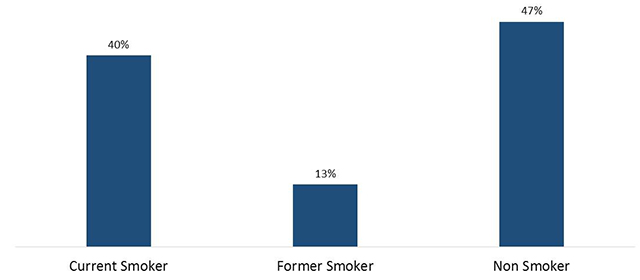
POR Number: 088-16
Contract Number: HT372-164514
Contract Award Date: 2016-12-22
Date of Submission: 2017-04-25
Prepared for: Health Canada
For more information, please contact: por-rop@hc-sc.gc.ca
April 2017
Ce rapport est aussi disponible en français.
Phoenix SPI is a 'Gold Seal Certified' Corporate Member of the MRIA
Health Canada commissioned Phoenix Strategic Perspectives Inc. to conduct qualitative and quantitative research with youth and young adult to explore issues related to e-cigarettes.
Under the current federal framework, vaping products are either regulated under the Food and Drugs Act (FDA) or the Canada Consumer Product Safety Act (CCPSA). Vaping products that contain nicotine or make a therapeutic claim must be authorized under the FDA by Health Canada before being sold. Vaping products without nicotine and without therapeutic claims do not require authorization by Health Canada but are subject to post-market requirements of the CCPSA.
The Government of Canada has launched an ambitious tobacco control agenda for Canada, which includes banning menthol in most tobacco products, implementing plain packaging requirements, introducing a new approach to regulating vaping products, and modernizing Canada's approach to tobacco control.
With respect to vaping products, the Government of Canada has introduced amendments that would establish the Tobacco and Vaping Products Act, a new legislative framework to regulate the manufacture, sale, labelling and promotion of these products in Canada. The proposed legislation aims to protect youth from nicotine addiction and inducements to tobacco use, while allowing adults to legally access vaping products as a likely less harmful alternative to tobacco. The new legislation would apply to a range of devices and substances, such as e-liquids, and cover vaping products with and without nicotine. The proposed legislation includes provisions that would ban the sale and promotion of all vaping products to persons under 18, prohibit the promotion of flavours that appeal to youth, and create regulatory authority to mandate the display of health warning messages on vaping devices and refill packages.
Though scientific knowledge is still emerging, Health Canada recognizes that vaping products could bring public health benefits if they reduce tobacco-related death and disease by helping smokers quit or switch completely to a likely less harmful source of nicotine. However, vaping products could also bring public health harms. There is a growing body of evidence that nicotine exposure during adolescence adversely affects cognitive function and development. Nicotine is also a potent and powerfully addictive substance, particularly for youth. There are concerns that vaping products could potentially lead to nicotine addiction, the use of tobacco products, and the renormalization of smoking behaviours.
There is a wide selection of flavours in e-liquids, some of which may be more appealing to youth. Health Canada is interested in better understanding how youth and young adult e-cigarette users engage with the product and how flavours factor into the appeal of the product for both users and non-users.
The 2014-2015 Canadian Student Tobacco Alcohol and Drugs Survey (CSTADS) asked students in grades 6 to 12 (grade 6 to secondary V in Quebec) about perceived harm associated with e-cigarettes. Almost one in four students (23%) thought there was "no risk" of harm from using an e-cigarette once in a while, compared to 9% who thought there was "great risk". Using an e-cigarette on a regular basis was thought to pose "no risk" of harm by 12% of students and great risk of harm by 25%. Almost one in six students (16%) were unaware how much a person risked harming themselves by using an e-cigarette once in a while or on a regular basis. The perception of risk of harm from smoking cigarettes and using e-cigarettes varied by smoking status. Current and former smokers attribute less risk to the use of cigarettes and e-cigarettes than never smokers.
E-cigarettes have been in the North American market for approximately a decade. With only a few studies available, data are limited on the knowledge, attitudes and beliefs of Canadians as they relate to e-cigarettes. Health Canada is interested in better understanding how Canadians, and in particular youth and young adults, are using e-cigarette products. Further, the study intends to explore the impact of flavours on the appeal to Canadian youth and young adults.
Qualitative and quantitative research was therefore required to better understand Canadians' perceptions on e-cigarette flavours, and perceptions of harms associated with e-cigarette use with a special focus on youth and young adults.
Specific objectives of the research were:
Findings from this study are intended to provide greater insight and understanding into how Canadians are interacting with e-cigarettes and what the appeal of e-cigarette products is, particularly among Canadian youth and young adults. The results will inform future regulation as well as contribute to future public awareness and education campaigns.
To meet the research objectives, qualitative and quantitative research was conducted with Canadian youth and young adults. Specifically: a series of 12 in-person focus groups in three locations across Canada; and an online survey of 1,509 Canadian residents between the ages of 15 and 24 years. Phoenix ensured that all steps in the research complied with market research industry standards and guidelines, including those of the Marketing Research and Intelligence Association (MRIA).
Phoenix conducted a series of 12 focus groups with youth and young adults between January 30th and February 2nd, 2017. Four sessions were conducted in each of Toronto, Montreal and Vancouver: two groups with non-users of e-cigarettes and two groups with e-cigarette users. The groups were segment by age: 15-19 year olds in one group, and 20-24 year olds in the other group. Each group included a mix of cigarette smokers and non-smokers. Groups lasted two hours and turnout was excellent, with at least eight participants taking part in each group. Recruitment was undertaken by Research House, under sub-contract to Phoenix, and participants received an honorarium of $125 in appreciation of their time. Parental consent was obtained for all 15 year olds who participated in one of the focus group discussions.
The 12 sessions were distributed as follows:
| Date and time | Location | Group Composition |
|---|---|---|
| January 30, 5:30 p.m. Eastern | Toronto, Ontario | Youth (users) |
| January 30, 7:30 p.m. Eastern | Toronto, Ontario | Youth (non-users) |
| January 31, 5:30 p.m. Eastern | Toronto, Ontario | Young adult (users) |
| January 31, 7:30 p.m. Eastern | Toronto, Ontario | Young adult (non-users) |
| February 1, 5:30 p.m. Eastern | Montreal, Quebec | Youth (users) |
| February 1, 7:30 p.m. Eastern | Montreal, Quebec | Youth (non-users) |
| February 1, 5:30 p.m. Pacific | Vancouver, British Columbia | Youth (users) |
| February 1, 7:30 p.m. Pacific | Vancouver, British Columbia | Youth (non-users) |
| February 2, 5:30 p.m. Eastern | Montreal, Quebec | Young adult (users) |
| February 2, 7:30 p.m. Eastern | Montreal, Quebec | Young adult (non-users) |
| February 2, 5:30 p.m. Pacific | Vancouver, British Columbia | Young adult (users) |
| February 2, 7:30 p.m. Pacific | Vancouver, British Columbia | Young adult (non-users) |
The groups in Toronto and Vancouver were conducted in English and those in Montreal in French.
The investigators for this study were Alethea Woods and Philippe Azzie. Alethea moderated the groups in Vancouver. Philippe moderated the focus groups in Toronto and Montreal. Both moderators contributed to the final report.
An online survey was administered to 1,509 Canadian youth (15-19 year olds, n=759) and young adults (20-24 year olds, n=750) between March 1st and 20th, 2017. The survey was designed to take up to 10 minutes to complete. The sample was drawn from Research Now's panel of online Canadians.1 Surveys that use samples drawn from online panels cannot be described as statistically projectable to the target population. Panellists were invited to participate in the survey through an email invitation which contained a password-protected URL to access the survey. Parental permission was obtained for youth 15 years of age. Panellists were rewarded for taking part in the survey per the panel's incentive program, which is structured to reflect the length of survey and the nature of the sample. Survey data has been weighted by region, age and gender to reflect the demographic composition of the target population. Because the sample is based on those who initially self-selected for participation in the panel, no estimates of sampling error can be calculated.
Users and non-users of e-cigarettes first learned of them in similar ways. These typically include friends/acquaintances/colleagues, seeing vapers using them, social media (e.g. ads on Facebook, YouTube videos, Snapchat), ads in stores and vape shop windows, and relatives using them to try to quit smoking. Contexts or situations in which users first tried e-cigarettes varied but the vast majority were offered their first e-cigarette (i.e. they did not purchase it themselves). Routinely identified situations in which they first tried e-cigarettes include at school, at parties, in bars/on patios, at friends' houses, in parks, and on break at work.
Routinely given reasons for first trying e-cigarettes include curiosity, appealing smell, social bonding (e.g. fun making clouds/doing tricks), and convenience (i.e. the ability to vape indoors). Some were encouraged to try by others, and some said they first tried it because it seemed 'cool' (e.g. allowed them to engage in smoking without the bad effects of smoking). Only a few started vaping in order to quit smoking.
Non-users have seen e-cigarettes used in many places, including all those places in which users first tried theirs. In addition, non-users have seen them used on buses, subways, in movie theatres, in class, in school halls, on university campuses, and in cars. Virtually all non-users have smelled e-cigarettes and most found the smell pleasant, mainly because it was sweet, fragrant, or fruity. Most non-users have had the opportunity to try e-cigarettes or been offered one, typically by friends, colleagues, relatives, and acquaintances.
E-cigarettes are used both indoors and outdoors. Indoor locations include one's own house, friend's houses, parties, bars, on subways, and in cars. Outdoor locations include school yards, while walking home, while waiting for the bus, on work breaks, and on restaurant or bar patios. Patterns of use do not tend to vary (indeed there do not tend to be any patterns) because use of e-cigarettes tends to be circumstantial. Most do not purchase their own and usually use them only if and when offered by a friend or only in the company of other vapers (i.e. a group setting). Smokers were more likely to distinguish their vaping behaviour from their smoking behaviour. They are more likely to vape inside and smoke outside, smoke for relaxation/stress relief and vape for fun/amusement.
Most vapers use cig-a-likes, but many have at least tried an advanced vaping device. Cig-a-likes are typically used because they are what is on offer from friends, they are cheaper, and they are ready to use. Vaping devices are preferred because they allow a more intense pleasure (i.e. better/stronger flavour), produce thicker smoke, allow more puffs, are more hobby-like (e.g. can be customized), and allow you to change or mix flavours.
All users seem to know whether their e-cigarettes contain nicotine or not, but few users of nicotine-filled e-cigarettes know the strength of nicotine they contain. All users have tried more than one flavour but all have their favourite flavours, mostly sweet (e.g. dessert-like) or fruit-like flavours. The main reason why vapers like the flavours they use is that it matches some of their consumption preferences (e.g. they like bubble gum, fruit, candy floss, cake, cappuccino).
Users typically use e-cigarettes for fun/pleasure and/or as a social bonding experience. For their part, non-users typically have not vaped because they find nothing appealing or attractive about it. Users and non-users tended to identify the same advantages and disadvantages of vaping. The main advantages included fun, pleasure, taste, social bonding, and convenience (i.e. ability to vape in many places including indoors). The main inconveniences included potential health risks/lack of knowledge of long-term health implications, cost, and social stigma.
Many users and non-users recall having seen advertising for e-cigarettes and they tended to identify the same locations or sources in terms of where they have seen ads and their content. Sources include television, online (e.g. Facebook, Youtube), in store/vape shop windows, in bus shelters, on buses, and in the metro/subway. Users and non-users also tend to agree on the target audience(s) of e-cigarette advertising. These include smokers in general, smokers trying to quit, and especially youth/young people. Users and non-users identified similar sources they would use to find information about e-cigarettes, with many adding that the source would depend on the information they were seeking. Google or the Internet were routinely identified first and most often.
Among both users and non-users, the most frequently identified important information for potential vapers was the possible long-term health effects of vaping and information about the content/ingredients in vaping liquids/flavours. Users and non-users also identified similar sources of information on the health benefits and risks of e-cigarettes. These typically included physicians, pharmacists, government sites (e.g. Health Canada), Universities, and research-based resources.
Both users and non-users tended to have difficulty identifying definite health risks or benefits associated with e-cigarettes. The only benefit identified with any frequency was the possibility of weaning oneself off cigarettes. The most frequently identified health risks were associated with lack of knowledge and information about the possible long-term health effects of vaping (e.g. lung problems resulting from inhaling vapour such as 'popcorn lung' or water on the lungs, possible allergic reactions, effects on pregnant women, abscesses, etc.)
Six in 10 respondents said that they do not smoke at the present time. Specifically, 47% are non-smokers and 13% are former smokers. Conversely, 40% are current smokers, of which 18% smoke daily and 22% smoke occasionally.
Just over half the respondents (53%) said they have never tried an e-cigarette, while the remainder (47%) said they have. Among all respondents, 15% said they use e-cigarettes occasionally and 6% do so daily. The rest are infrequent (14%) or one-time (13%) users. The likelihood of having tried e-cigarettes was higher among young adults (20-24 years old) than among youth (15-19 years old). Nearly two-thirds of users were between 16 and 18 years of age (32%) or 19 and 21 years of age (31%) when they first tried an e-cigarette. Half (51%) of all e-cigarette users indicated that their parents are aware that they use e-cigarettes.
Friends are, by far, the most common source through which respondents first learned about e-cigarettes, with close to two-thirds (62%) saying this is how they initially heard about them. Friends were identified twice as often as the next most frequently cited source which was social media (31%). Young adults were more likely to have heard about e-cigarettes from their co-workers. Conversely, youth were more likely to have first learned about e-cigarettes from YouTube. Friends also topped the list of people in respondents' lives who use e-cigarettes. Just over half (53%) indicated that they have friends who use e-cigarettes.
Most daily and occasional vapers have not tried quitting (64%), but a significant minority (43%) think they will stop using e-cigarettes at some point. A majority (58%) of smokers who vape daily or occasionally have used e-cigarettes as a quitting aide. Among those who have not, 62% said they would be somewhat or very likely to do this.
Most e-cigarette users (64%) know that e-cigarettes sometimes contain nicotine. Compared to youth, young adults were more likely to say that e-cigarettes always and sometimes contain nicotine. Conversely, youth were more apt to believe that e-cigarettes never contain nicotine.
One-time users of e-cigarettes said they tried e-cigarettes because their friends were vaping (43%), because they liked the flavours and smell (40%), and because it was offered to them (39%) (multiple responses accepted). Youth were more likely to say they tried e-cigarettes because their friends were vaping. Conversely, young adults were more likely to say they tried because they liked the flavours and smell. One-time and infrequent users of e-cigarettes were divided over whether they would try an e-cigarette again: 38% said they would, 32% said they would not, and 30% said they did not know. The main reasons cited for not using an e-cigarette again were that it's not healthy (40%) and that it's unappealing (37%).
Many daily and occasional vapers use e-cigarettes at home (59%). A substantial minority (43%) said they tend to use them at parties, while approximately one-quarter identified the sidewalk (29%), school (26%), while driving (24%), and work (23%) (multiple responses accepted). Respondents 20 and 24 years old were more likely to say they use e-cigarettes at home and while they are driving. Those between 15 and 19 were more apt to say they use them at parties, at school, or at movie theatres or pool halls. Three-quarters of daily users of e-cigarettes2 (76%) said, that in a typical day, they vape within one hour of waking up, with almost half (46%) doing so almost immediately after waking (i.e. within 15 minutes of waking). More than half of daily users (57%) said they have strong cravings to use an e-cigarette.
More than three-quarters (77%) of daily and occasional users of e-cigarettes said they own their own device. Among those who own a device, more than half (58%) said they always use a device that can be refilled. Regarding nicotine, 54% said they sometimes use nicotine in their e-cigarette. Conversely, nearly one-quarter (23%) always use nicotine, while approximately one in five (19%) never use nicotine. Half of the respondents who use nicotine in their e-cigarette (51%) do not know what concentration of nicotine they use.
The most popular flavour by far among e-cigarette users is fruit. Asked what flavour they used last time they vaped, over one-third (37%) said fruit. Fruit is also the preferred flavour of e-cigarette users. Nearly half of daily and occasional e-cigarette users (47%) acquire their e-cigarettes by purchasing them themselves. Fewer, but a sizeable proportion nonetheless, said they usually borrow their e-cigarettes or get them from someone else. This includes 17% who said they get them from friends, 8% from someone else, and 7% from family members. Fourteen percent said they ask someone to purchase e-cigarettes for them.
Users of e-cigarettes collectively identified numerous reasons why they vape, but flavour and aroma topped the list with nearly half (45%) identifying this as the reason they use e-cigarettes. Following this, close to one-third explained that they vape because their friends do (31%) or because it's safer than smoking traditional cigarettes (30%) (multiple responses accepted). The two perceived disadvantages of using e-cigarettes most frequently identified by vapers were the associated health risks and the cost, each identified by 55% of e-cigarette users.
Turning to perceptions of potential harm, smoking cigarettes and using e-cigarettes with nicotine were seen as the riskiest activities. Nine in 10 respondents rated regular use of cigarettes as at least moderately risky, while 82% felt that way about regular use of e-cigarettes containing nicotine. Apart from using nicotine-free e-cigarettes once in a while, non-users of e-cigarettes were more likely than e-cigarette users to perceive every risk as a great risk. Occasional use of nicotine-free e-cigarettes was the only activity which a majority (59%) viewed as posing no more than a slight risk.
Attitudes towards e-cigarettes and nicotine tended to be mixed. The only majority view related to addiction and nicotine. Over three-quarters agreed that one can become addicted to e-cigarettes containing nicotine (79%) and that nicotine is a toxic chemical that should be avoided (77%).
Information on health effects (42%) is the most common type of information sought by users of e-cigarettes. This was followed by information about content/ingredients, with one-third looking for information on ingredients (33%) and chemicals (32%) in e-cigarette liquids. Just over one-quarter (27%) have looked for safety information, including general product safety and information about explosions and device defects, while almost as many have looked for information comparing e-cigarettes to regular cigarettes (24%), information about choosing nicotine levels (24%), and information about the cost of e-cigarettes (23%) (multiple responses accepted). Online sources in one form or another constitute the main source of information for users of e-cigarettes. The most frequently identified non-Internet source of information was friends and colleagues, identified by just over one-quarter of respondents (28%).
The report presents the findings from the qualitative research, following by the findings from the quantitative research.
The expressions 'users of e-cigarettes' and 'vapers' are used interchangeably throughout the report to refer to focus group participants and survey respondents who use e-cigarettes. The expression 'vaping' is used at times to refer to the use of e-cigarettes.
Qualitative findings:
Overall, differences by age (i.e. between youth and young adults), by use of e-cigarettes (users vs. non-users), and by location (i.e. Toronto, Montreal, Vancouver) were limited. Wherever such differences manifested themselves they are noted.
This research is qualitative in nature, not quantitative. As such, the results provide an indication of participants' views about the issues explored, but cannot be generalized to the full population of youth and young adult non-smokers, smokers and e-cigarette users and non-users.
Quantitative findings:
All quantitative results in the report are expressed as percentages, unless otherwise noted. Throughout the report, percentages may not always add to 100% due to rounding and questions which permitted multiple responses.
Demographic and other subgroup differences are identified in the report. When reporting subgroup variations, only differences that are significant at the 95% confidence level, indicative of a pattern, and/or pertaining to a subgroup sample size of more than n=30 are discussed in the report.
The results are reflective of youth and young adult non-smokers, smokers and e-cigarette users and non-users, but they cannot be considered representative of the target population because random sampling was not used. When non-probability sampling is used, the extent to which the survey sample represents the target population is not known (because probability theory cannot be applied).
The full set of tabulated data for the survey are available under separate cover.
The research instruments for both phases of the research are appended to this report.
The contract value was $149,077.09 (including applicable taxes).
This section of the report describes the findings from the qualitative research (the focus groups).
This section provides background information about users and non-users of e-cigarettes.
Both youth and young adult users of e-cigarettes tend to be recent vapers. A majority of e-cigarette users in every group said they have been vaping for less than one year and many said they only tried their first e-cigarette within a few months of the research. Only a small number have been vaping for more than one year, and the longest anyone has been vaping is approximately three years.
In addition to being recent users of e-cigarettes, most vapers tend to describe themselves as occasional users. For the most part, use of e-cigarettes as reported by vapers ranges from a few times a week to less than once a month. Some occasional users indicated that their use of e-cigarettes may vary because they borrow e-cigarettes from their friends. Consequently, their use depends on the availability of e-cigarettes through their friends. Only a small number are daily users of e-cigarettes, and most of these were in Vancouver. A few users of e-cigarettes in other locations specified that they used to be daily users but are not anymore.
Every group with users of e-cigarettes included at least a few smokers of regular cigarettes as well, but most of these said they smoke cigarettes occasionally rather than daily. The most frequently given reason for smoking both cigarettes and using e-cigarettes was that smoking is addictive or a bad habit that relieves stress and/or helps them relax whereas vaping is an amusement and/or a fun social activity.
Other reasons for vaping and smoking cigarettes tended to emphasize advantages of vaping over smoking. These included taste (i.e. vaping tastes good), convenience (i.e. e-cigarettes can be used indoors), and the fact that vaping does not make one's clothes smell bad. Only a few indicated that they use e-cigarettes to wean themselves off cigarettes while a few other daily smokers noted that this was the reason they first started using e-cigarettes but that it has not worked for them.
Every group of non-users of e-cigarettes included at least a few participants who are smokers of regular cigarettes. Like their counterparts among e-cigarette users most of these smoke cigarettes occasionally rather than daily. The length of time they have been smoking varies widely, ranging from as recently as one year to as long as ten years, but most have been smoking somewhere between 1-3 years.
Only a few smokers said they have tried to quit smoking. Some who haven't tried volunteered that they feel no real need to quit smoking because their consumption of cigarettes is only occasional. In other words, while they see smoking as a bad habit they do not see it as an addiction. Since they feel they can quit smoking anytime they do not feel dependent and therefore see no reason to quit.
All non-users of e-cigarettes had heard of e-cigarettes prior to the research and are familiar with them at least to some extent. Asked what they know about e-cigarettes, non-users collectively identified a variety of things, but the only thing identified routinely in every group was that e-cigarettes can be used as a way to quit smoking, though a few added that they may not be effective in this regard.
Presented below is a list of other things identified by non-users as 'known' about e-cigarettes. Most of these things were identified by at least a few participants in all groups of non-users. They have been grouped by category so as to facilitate review. When reviewing the list, it should be kept in mind that while participants were asked what they 'know' about e-cigarettes, they were not always certain that their impressions were correct.
Characteristics/features of e-cigarettes
Availability
Potential risks/dangers
This section reports on the circumstances under which participants first encountered e-cigarettes.
Both users and non-users of e-cigarettes first became aware of them in similar ways. These ways typically included learning about them through friends, acquaintances, colleagues/co-workers, and family members, seeing e-cigarettes used in public (e.g. on the street, in bars/pubs, outside at school), seeing them in convenience stores or seeing ads in convenience stores, and seeing vape shops and ads in vape shop windows.
Many also recall first hearing about e-cigarettes through social media. This included hearing about them through Facebook, YouTube, Snapchat, and Instagram. Some recall hearing about e-cigarettes through a television ad or through TV news and one participant trying to quit smoking heard about them through her physician. Nearly all non-users said they know someone who vapes (e.g. friends, students at school, colleagues, family members).
While the specific circumstances in which users of e-cigarettes first tried one varied, the vast majority of them said they were offered their first e-cigarette (i.e. they did not purchase it themselves). Routinely identified circumstance in which users first tried an e-cigarette include outside at school, at house parties, in a bar/on a nightclub patio, at a friend's house, in a park, and on a break at work. Some participants specified that they first tried an e-cigarette in their own home or a relative's home and that they were offered the e-cigarette by a relative or family member. The common element underlining all these circumstances is that users tried their first e-cigarette in a group setting.
Those who purchased their first e-cigarette were far more likely to do so from a convenience store than from a vape shop. A few of those who purchased their first e-cigarette specified that they did not purchase it alone or individually but rather purchased it with others in order to share it.
For their part, most non-users said they have had the opportunity to try an e-cigarette or have been offered one. Moreover, the contexts in which they were offered e-cigarettes were the same as those in which most users first tried theirs. In other words, non-users were most often offered an e-cigarette by friends, colleagues, relatives, and acquaintances in the types of circumstances identified above (e.g. at school, at house parties, in a bar/on a nightclub patio, at a friend's house).
Among users of e-cigarettes, routinely given reasons for first trying one included curiosity, the appealing smell/aroma, and the social bonding aspect of vaping (e.g. having fun, making clouds/doing tricks). Reasons identified less frequently but by at least a few participants in all groups with e-cigarette users included convenience (i.e. the ability to vape indoors), encouragement from others, the impression that it is 'cool' or 'trendy' and the ability to engage in the experience of smoking without the bad effects of smoking. Only a few users said they started vaping in order to quit smoking.
For their part, non-users most often explained their lack of interest in vaping by saying that they find little or nothing appealing or attractive about it. Lack of appeal was ascribed to a variety of factors:
Some described vaping as unappealing because it amounts to 'pretend smoking' and that if one wants to smoke one should just smoke cigarettes. Since they do not want to smoke, they see no reason to vape either.
Some said they see nothing appealing in what was described by one participant as 'inhaling what they like to eat', the suggestion being that users of e-cigarettes tend to choose flavours that correspond to foods or tastes they find appealing.
Some described vaping as unappealing because the experience strikes them as 'juvenile' or 'dorky', consisting in such activities as making clouds and blowing smoke. This impression was most likely to be articulated by young adult non-users.
A few described vaping as unappealing because they do not like being exposed to smoke or inhaling vapours.
Other routinely identified reasons for not vaping included health concerns and/or apprehensions due to a lack of information about potential health risks, the fact that they have no friends or acquaintances who vape, and the perception that it is costly and/or a waste of money.
Reasons for not vaping mentioned by small numbers included the impression that it is a bad habit and possible gateway to smoking, apprehensions that e-cigarettes can malfunction (i.e. explode), the impression that e-cigarettes are designed to help people stop smoking and they themselves do not need such help, and the impression, identified by a few smokers, that e-cigarettes will not help them quit smoking.
Despite its lack of appeal to them personally, virtually all non-users have smelled e-cigarettes and most said that they found the smell pleasant, often describing the aroma as 'sweet', 'fragrant', or 'fruity'. Those who did not like the smell were more likely to be neutral about the aroma than negative about it. Those who did not like the smell described it either as too sweet, too strong, or unnatural/artificial.
This section reports on patterns or behaviors when it comes to using e-cigarettes. Given the focus on the use of e-cigarettes, feedback in this section was provided mainly by users of cigarettes. However, in some instances relevant feedback from non-users is included.
Users of e-cigarettes tend to vape in a variety of locations, both indoors and outdoors. Indoor locations usually include their own house, friend's houses, and bars/pubs/night clubs. Some also said they have vaped on subways, in cars (i.e. while driving or being driven), and in the halls at school. Outdoor locations routinely include schoolyards and college campuses, parks, on the street in general, while waiting for the bus, outside the office during work breaks, and on restaurant or bar patios.
For their part, non-users have seen e-cigarettes used in many places, including all the places in which users indicated that they tend to vape. In addition to these locations, non-users have seen them used on buses, subways, in movie theatres, and in class. A few have also seen them used in their own houses by relatives trying to quit smoking.
Most users of e-cigarettes indicated that their usage patterns do not tend to change or vary depending on who they are with or where they are. The main reason why is that their use of e-cigarettes tends to be occasional and circumstantial (i.e. they do not vape on a regular basis and usually only do so with friends/acquaintances in social situations). In short, there is relatively little structure to vaping behaviour. Indeed, the only patterned behaviours related to vaping were identified by individual vapers and included the following:
Smokers who vape tend to distinguish their use of e-cigarettes from their use of regular cigarettes. This was especially the case among regular smokers and daily vapers. The following differences were identified:
This section reports on the purchasing habits of e-cigarette users, including the types of devices and flavours they use. Given the focus, feedback in this section comes almost exclusively from users of e-cigarettes, with some relevant feedback from non-users included at the end.
Most users of e-cigarettes said that they do not usually purchase their own. They are much more likely to borrow e-cigarettes and use them only if and when offered by a friend or in the company of other vapers. Those who purchase their own e-cigarettes are most likely to acquire them in a convenience store. Some have purchased them from a vape shop and a few have purchased them online. Those who purchase their e-cigarettes from a vape shop or online were most likely to be frequent or regular users of e-cigarettes.
A few users said they usually have friends purchase them (i.e. they provide the money and the friend purchases the e-cigarettes), while a few others indicated that they typically tend to pool their funds with friends and purchase e-cigarettes to share.
Nearly everyone purchases liquids and devices from the same place for reason of convenience. Some volunteered that since they use disposable e-cigarettes this is not an issue. The few who purchase their devices and liquids from different places explained that they tend to purchase specialty liquids from a particular shop.
Most vapers said they use cig-a-likes, though many have at least tried an advanced vaping device. Routinely given reasons for using cig-a-likes are that they are cheaper, convenient because ready to use, and usually what is on offer from friends. Regarding the latter point, many re-iterated that they tend to borrow rather than purchase e-cigarettes and that as a result of this they tend to use whatever is on offer. Some also explained that they use cig-a-likes because they only vape occasionally so there is no reason to purchase a more sophisticated type of vaping device. Users of cig-a-likes use, or have used, both rechargeable and disposable types, with many again adding that it depends on what is on offer because they tend to borrow e-cigarettes from friends.
Routinely given reasons for using advanced vaping devices included the impression that they provide a more intense pleasure (i.e. better/stronger flavour), produce thicker smoke, and last longer (i.e. allow more puffs). It was also observed that advanced devices allow the whole experience of vaping to acquire a hobby-like character (e.g. devices can be customized, liquids can be changed or mixed). Only a few users said they have customized their own device. This includes building coils, mixing flavours, and purchasing accessories (e.g. a tank guard).
User experience with e-cigarettes varies when it comes to the content of e-cigarettes. Vapers include people who use nicotine filled e-cigarettes, nicotine-free e-cigarettes, or both. Virtually all users said they know whether their e-cigarettes contain nicotine or not. On the other hand, only a small number of users of nicotine-filled e-cigarettes said they know the strength of nicotine they contain.
Users of nicotine-filled e-cigarettes who know the strength nicotine content are people using them (or who have used them) to try to quit smoking. Specific strengths identified by these users include 8 mgs, between 3-9 mgs, between 6-12 mgs and between 8-16 mgs. A few have changed the strength of nicotine content over time, either to help wean themselves off cigarettes or because they found that a higher dose of nicotine made the experience less pleasant (e.g. the higher dose hurt their lungs).
Among users of nicotine-free e-cigarettes most said they began that way (i.e. they have only ever used nicotine-free versions), but some said that they changed from nicotine to nicotine-free versions because of health concerns or because they did not like the taste of e-cigarettes containing nicotine.
Virtually all users of e-cigarettes said they have tried more than one flavour. Most have tried a limited number, ranging somewhere between 2-5 flavours. On the other hand, many say they have tried a wider variety of flavours, ranging anywhere between 10 flavours and over 50. Although users of e-cigarettes have tried a variety of flavours, their current use tends to be limited. Indeed, most said they currently tend to use only one flavour and those who currently use more than one flavour tend to limit themselves to a few options.
Both those who currently use only one flavour and those who currently use more than one flavour routinely provided the same reason to explain why: they have a favourite flavour or favourite flavours. For the most part, users said they prefer sweet flavours, usually fruit-like flavours but also dessert or candy-like flavours. Favourite flavours identified included the following (presented in alphabetical order):
Among those who currently use more than one flavour, reasons offered less frequently for doing so included a desire for some variety and a desire to experiment/curiosity. A small number also linked use of more than one flavour to following a pattern regarding their use of flavours (see details below under heading Few follow a pattern in their use of flavours). Among those who currently use only one flavour reasons offered less frequently included cost, habit, and limited use of e-cigarettes.
A number of participants indicated that the extent to which they use one or more flavours is at least partly dependent on the fact that they are occasional users of e-cigarettes who tend to borrow them rather than purchase them. Consequently, the number of flavours they currently use depends in part on what is on offer from their friends.
Most users of e-cigarettes also said they rarely or very rarely change flavours and the reasons given to explain why tended to be the same ones identified above to explain why they use the flavour(s) they currently use (i.e. preferred flavour/flavours, habit, and limited use of e-cigarettes). Once again, a number of users indicated that the extent to which they change flavours depends in part on the fact that they tend to borrow e-cigarettes rather than purchase them (i.e. it depends in part on what is on offer from their friends).
Relatively few users indicated that they switch flavours often or on a regular basis. Reasons given to explain frequent or regular changes included the following, none of which was offered by more than a couple of individuals: a tendency to switch flavours when they run out of a certain liquid, curiosity about other flavours, and a desire for a change of taste.
Only a few participants said they follow any kind of pattern when it comes to the flavours they use. The pattern in question involved matching vaping behaviour to consumption patterns (i.e. a breakfast-like flavour in the morning like coffee and a dessert-like flavour in the evening like cake).
What most appeals to vapers about the flavours they use is the taste and aroma, with many adding that the flavours they like mirror their consumption preferences (e.g. they like fruit, desserts, coffee, etc.). While some indicated that they first tried flavours based on trial and error, what was offered to them, or simply curiosity, what appeals to them principally is taste and aroma.
Related to this emphasis on taste, many said that what appeals to them about the flavour(s) they use is the aftertaste, observing that what they like about the flavour they use is that it makes their mouth feel clean and/or their breath feel fresh. A few observed that the flavour they like is also appealing to others around them who do not vape. A small number of users said that what they find appealing about the flavour they use is that it is popular or commonly used by friends and acquaintances.
Few users of e-cigarettes said they have tried non-descriptive flavours and none currently use a non-descriptive flavour. Those who have tried such flavours said they did so mainly out of curiosity at the name (though only a couple could recall the name of the flavour they tried3) and/or because the flavour in question is what was on offer at the time.
Asked who they think flavours with non-descriptive names such as "island breeze", "unicorn puke", or "golden ticket" are marketed to, there was widespread agreement that such names target youth or young people. There was also widespread agreement among non-users that such names are designed to target youth or younger people.
Users and non-users of e-cigarettes identified two main reasons to explain why they think such names target younger people.
The impression that younger people are more likely to be curious and adventurous and therefore more likely to be attracted to things that sound strange or out of the ordinary.
The impression that young people are more likely to be impressionable and attracted to what seems fashionable and trendy, especially if it seems to be outside the mainstream. With this in mind, a few non-users suggested that such names would appeal to what was described as 'edgy teens' and 'hipsters'.
Some participants suggested that youth or young people are targeted because a name like 'unicorn puke' sounds 'juvenile' and most likely would not appeal to mature people or adults, though some suggested that it might appeal to adults who wants to seem 'young' or 'cool'.
Some participants think that non-descriptive flavours do not target a specific age group but are designed to appeal to the 'curious' in general. A few participants also suggested that names such as these might be designed to attract non-smokers and women. Regarding non-smokers, the suggestion was that these names make the product sound fun and harmless and therefore might be designed to appeal to people who do not want to start smoking because it is dangerous. Regarding women, it was suggested that a name like "island breeze', with its emphasis on fragrance, has a feminine undertone to it which might be designed to target women.
This section reports on reasons for using e-cigarettes, as well as on perceived advantages and disadvantages of vaping.
Users of e-cigarettes collectively identified various reasons why they vape but two reasons dominated and were often identified together: it is a fun/pleasant experience and a social bonding experience. A key factor in making the experience pleasant or fun is the taste and/or aroma of e-cigarettes. While some identified taste as a distinct reason for vaping, many identified it as part of what makes the experience fun or pleasant. The emphasis on the social bonding aspect of vaping underscores what by this point in the discussion had emerged as a recurring theme in all groups: the fact that most users vape in the company of others. The ability to perform tricks was sometimes linked to the social bonding aspect of vaping and sometimes identified separately.
Two additional reasons for vaping were also identified relatively frequently, but were more likely to be emphasized by cigarettes smokers: convenience (i.e. the ability to vape indoors) and the absence of smell on oneself/one's clothes. A few cigarette smokers also said they use e-cigarettes in order to try to quit smoking or cut down on their smoking. Reasons identified infrequently included curiosity, the impression that it is a harmless pastime, the ability to make a hobby out of it (e.g. customizing one's device), the impression that it is fashionable/cool, and the impression that it complements drinking alcohol.
Both users and non-users of e-cigarettes tended to identify the same advantages of vaping. Routinely identified advantages included fun/pleasure, taste and aroma, social bonding, and convenience (i.e. ability to vape in many places including indoors). The following reasons were identified less frequently, but were still identified in most groups:
Advantages identified by individuals or no more than a few participants included the following:
As was the case with perceived advantages, users and non-users of e-cigarettes tended to identify the same disadvantages of vaping. The most frequently identified inconveniences included potential health risks and lack of knowledge of long-term health implications of vaping. Although identification of both was widespread, they were more likely to be identified by non-users of e-cigarettes.
Also identified relatively frequently were the cost of vaping (including refills and repairs), and social stigma. Regarding the latter, the impression was that while vaping is not as stigmatized as smoking there is nonetheless a stigma associated with it, based primarily on the impression that it is a 'silly' activity (e.g. standing around blowing smoke and doing tricks). Some also linked the stigma to the impression that vaping is offensive to many non-vapers who do not like being in a smoke-filled environment. Social stigma was also more likely to be identified as a disadvantage by non-users of e-cigarettes.
Perceived disadvantages identified less frequently but in all groups included the following:
Perceived disadvantages identified by individuals or no more than a few participants included the environmental impact of vaping (e.g. how are devices, including batteries, disposed of), and the impression that vaping is an unregulated activity (i.e. there do not seem to be laws governing it to date).
None of the vapers consider themselves to be dependent on e-cigarettes, routinely explaining that their use is only occasional, that they vape only for fun, and that it is harmless, especially if the e-cigarette contains no nicotine. Some added that they feel no need to vape or cravings, which would be an indication that they are dependent on e-cigarettes.
Most vapers also pointed to their limited or occasional use of e-cigarettes and the perception that it is a harmless activity to explain why they do not see themselves stopping. On the other hand, a few vapers said they already have stopped or will stop in the future. Reasons included the fact that their friends no longer vape, that they are pregnant, and that vaping has not helped cut down on smoking.
For their part, virtually none of the non-users see themselves as likely to start. Their reasons for not starting mirrored their reasons for not trying in the first place (i.e. lack of appeal, health-related concerns, absence of friends who vape, and perceived waste of time and money). A few said they might try it at some point in the future out of sheer curiosity.
Most non-users of e-cigarettes who smoke said they do not see themselves as starting to vape as an aid to help them quit smoking. The main reason given was that they are occasional smokers and therefore see no need to wean themselves off cigarettes. One smoker added that there is no proof that vaping helps one quit smoking, which is why he/she does not plan to start. On the other hand, a few regular smokers said they might try vaping at some point in the future as an aid to help them quit smoking.
This section reports on issues related to information about e-cigarettes.
Virtually all users and non-users recall having noticed advertising for e-cigarettes. Routinely identified locations include social media such as Facebook, Youtube, and Instagram, convenience stores, vape shop windows, bus shelters and buses, and in the metro/subway. Some also recall seeing ads on television, hearing an ad on the radio, and seeing ads in newspapers and advertising flyers (publi-sacs).
Asked about the nature of the ads, participants who could remember the content of the ads recall the focus being on the following types of things:
Users and non-users tend to agree on the main target audience(s) of e-cigarette advertising. A majority of participants in every group think there are two main target audiences: smokers, especially smokers trying to quit, and youth/young people. Smokers, and particularly smokers trying to quit, were identified as a target audience because they are seen as susceptible to being influenced by one or more of the following ideas:
Youth and young people (identified by a few as somewhere within the 16-25 age range) were seen as a target audience for the following reasons:
Some participants felt that the target audience for e-cigarettes is wider than youth and smokers. These wider audiences were seen to include people who like gadgetry and technology, people who are curious and like to try new things, and adults trying to act young or seem 'cool'.
Users and non-users identified similar sources they would use or go to in order to find information about e-cigarettes, with many adding that the source would depend on the information they were seeking. Google or the Internet (including social media) were routinely identified first and most often as a source of information. Other routinely identified sources included vape shops/vendors, friends and acquaintances who vape, research/evidence-based sources (e.g. PubMed, physicians, universities, government, news sites), and vendors/manufacturers of vaping products.
Routinely given reasons for using various sources included the following:
Vendors/manufacturers: This source would be used for information about the products themselves (e.g. what is available/range of products, cost, how devices work, maintenance and upkeep).
Friends/acquaintances who vape and social media: These are seen as a source of practical information based on first-hand experience with e-cigarettes.
Research/evidence-based sources: These are seen neutral sources for objective information/data on such things as the health effects/implications of vaping, the content/ingredients of liquids, and possible defects/malfunctions associated with e-cigarettes.
YouTube: Seen as a good source for testimonials and tutorials/demos on such things as customizing one's device.
Wikipedia: Seen as a good first stop for general information.
Users and non-users routinely identified the possible long-term health effects of vaping and information about the content/ingredients in vaping liquids/flavours as the most important information for someone to have in order to make an informed decision about whether or not to begin using e-cigarettes. Other types of information were identified much less frequently but came up in most groups. They included the following:
Asked if there is any information they do not currently have about e-cigarettes but would like to have, non-users routinely identified the possible long-term health effects of vaping and information about the content/ingredients in vaping liquids/flavours. Types of information identified by smaller numbers or by individuals included the following: how to regulate the nicotine content in e-cigarettes, are e-cigarettes addictive, and are there any side-effects associated with vaping.
This section reports on issues related to possible health benefits and risks associated with e-cigarettes, as well as on sources of information about health benefits and risks.
Discussion about health risks associated with e-cigarettes was framed by participants' self-declared lack of knowledge and information about the possible long-term health effects of vaping and lack of knowledge about the ingredients in vaping liquids. This lack of knowledge provided the context within which participants in every group raised questions or voiced concerns about potential health problems/issues resulting from the use of e-cigarettes. These included the following:
Users and non-users of e-cigarettes had difficulty identifying specific benefits associated with e-cigarettes. Indeed, the only health benefit identified with any frequency was the possibility of weaning oneself off cigarettes. Beyond this the only benefits associated with e-cigarettes were the possibility of stress relief and the possibility that they are not as bad as cigarettes. A number of participants, primarily non-users of e-cigarettes, said they can think of no health benefits associated with e-cigarettes.
As part of the discussion of the health benefits and risks of e-cigarettes, participants were given a hand out which asked them to rate their level of agreement with the following statement: I believe e-cigarettes are no better than smoking regular cigarettes. In addition to rating their level of agreement with the statement participants were asked to explain their opinion.
Participants' views on the extent to which e-cigarettes are or are not better than cigarettes varied. In almost every group opinion was divided between those agreeing with the statement, those disagreeing, and those neither agreeing nor disagreeing. To the extent that a pattern emerged it was between users and non-users of e-cigarettes, with non-users more likely to agree that e-cigarettes are no better than regular cigarettes, and users more likely to disagree that they are no better than cigarettes.
Those who disagreed with the statement that e-cigarettes are no better than cigarettes provided the following reasons to explain their opinion:
Those who agreed that e-cigarettes are no better than cigarettes provided the following reasons to explain their opinion:
Finally, those who neither agreed nor disagreed with the statement most often pointed to lack of knowledge or information to explain their position or indicated that it depends on whether or not the e-cigarette contains nicotine or not. Other reasons for taking a more neutral stance included the impression that e-cigarettes are designed to help people quit smoking but they might also act as a gateway to smoking, that inhaling anything but oxygen into one's lungs could be risky, and that it depends on whether the e-cigarettes contain nicotine or are nicotine-free.
In some instances, participants used the same reason to justify different opinions. For example, some felt that e-cigarettes are no better than cigarettes due to lack of knowledge about their long-term health effects, while some used the same reasoning to take a neutral stance on the issue.
Users and non-users of e-cigarettes identified similar sources they would go to for information about the health benefits and risks of e-cigarettes. Sources identified most frequently included physicians, pharmacists, government/government websites, Health Canada, universities, and research-based resources such as PubMed, scientific journals, and Google scholar. Sources mentioned less frequently included Reddit, Wikipedia, friends and acquaintances, the World Health Organization (WHO), the Food and Drug Administration (FDA), and vendors of e-cigarettes.
Reasons for using these sources revolved primarily around the issue of trust. Such sources were described using expressions such as 'credible', 'authoritative', 'neutral', 'objective', and 'disinterested'. In the case of vendors, it was suggested that they would be obliged to provide health-related information. In the case of friends and acquaintances it was suggested that they would have first-hand experience about the health impact of using e-cigarettes. In addition, some said they would go to the sources they identified because these sources would be most likely to have up-to-date information about the health effects of e-cigarettes or know where to find such information.
This section of the report describes the findings from the online survey.
Overall, six in 10 said they do not smoke at the present time. Specifically, 47% are non-smokers and 13% are former smokers. Conversely, 40% of survey respondents are current smokers, of which 18% smoke daily and 22% smoke occasionally. Respondents who are 20 to 24 years old were more likely than those who are 15 to 19 years old to be both current (46% vs 34%) and former smokers (15% vs 11%).
Figure 1: Smoking Status (Traditional Cigarettes)

Base: n=1,509; all surveyed respondents
This includes cigarettes that are bought ready-made, as well as cigarettes that people make themselves.
Compared to Ontarians, respondents from Quebec were less likely to be current smokers (35% vs 45%), and men were more likely than women to be current smokers (43% vs 36%). In addition, the likelihood of currently smoking was higher among e-cigarettes users than non-users (69% vs 14%).
The vast majority of youth and young adult smokers (n=607) have been smoking cigarettes for five years or less (82%); only 16% said they have been smoking for more than five years. Young adults (age 20 to 24) were more likely to be daily smokers, as well as more likely to have been smoking for more than 5 years. Women were significantly more likely than men to have started smoking cigarettes less than a year ago (27% vs 19%).
Figure 2: Length of Time Smoking

Text Description - Figure 2: Length of Time Smoking
Base: n=607; those who smoke currently
Q5. How long have you been smoking cigarettes?
Just over half the respondents (53%) said they have never tried an e-cigarette, while the remainder (47%) said they have tried e-cigarettes. Respondents were offered the following description of e-cigarettes:
E-cigarettes are battery-powered vaping devices which are sometimes designed to look and feel like regular cigarettes. These devices are used to heat e-liquid into vapour you can inhale.
Figure 3: Use of E-Cigarettes
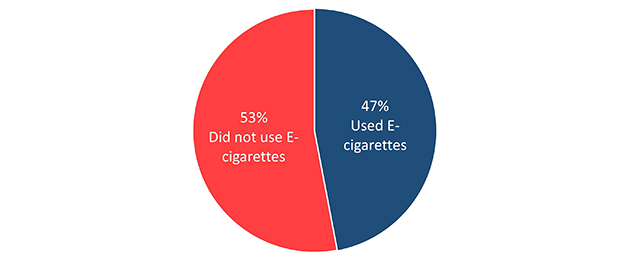
Text Description - Figure 3: Use of E-Cigarettes
Base: n=1,509; all surveyed respondents
Q7. Have you ever tried an electronic cigarette, also known as an e-cigarette?
The likelihood of having tried e-cigarettes was higher among young adults (20-24 years old) than youth (15-19 years old) (51% vs 43%), and among men compared to women (50% vs 44%).
Respondents were more likely to say they are occasional e-cigarette users. While 53% do not use e-cigarettes, 15% said they do so occasionally and 6% do so daily. In addition, 14% are infrequent users, and 13% said they have used an e-cigarette once. Men were more likely than women to be daily users.
When asked how old they were when they first tried an e-cigarette, e-cigarette users (n=713) were more likely to say they were between 16 and 21 years of age. Nearly two-thirds of users were between 16 and 18 years of age (32%) or 19 and 21 years of age (31%) when they first tried an e-cigarette. An additional 20% said they were between 12 and 15 years old, while 18% were 21 to 24 years old when they first tried an e-cigarette.
Figure 4: E-Cigarette User Profile Frequency of Use

Text Description - Figure 4: E-Cigarette User Profile Frequency of Use
Base: n=1,509; all surveyed respondents
Q12. Which of the following statements best describes your use of e-cigarettes?
Figure 5: E-Cigarette User Profile Age of First Use
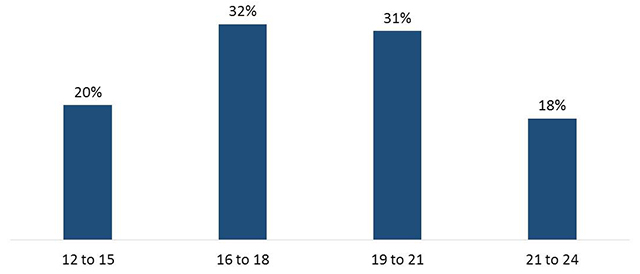
Text Description - Figure 5: E-Cigarette User Profile Age of First Use
Base: n=713; all e-cigarette users
Q13. How old were you when you first tried an e-cigarette?
The large majority of e-cigarettes users who are current or former smokers said they tried traditional cigarettes before e-cigarettes. Fully 83% said they tried traditional cigarettes first, followed by e-cigarettes.
Figure 6: Path of Use
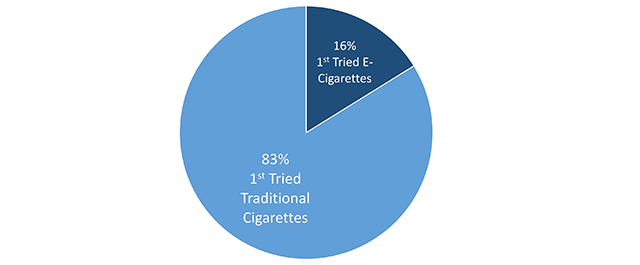
Text Description - Figure 6: Path of Use
Base: n=613; those who use e-cigarettes, are smokers and are former smokers
Q8. Which did you try first?
Youth were more likely to have used e-cigarettes first (21% vs 13%), while young adults were more likely to have tried regular cigarettes first (86% vs 78%).
Friends are, by far, the most common source through which respondents first learned about e-cigarettes, with close to two-thirds (62%) saying this is how they initially heard about them. Friends were identified twice as often as the next most frequently cited source which was social media (31%). This was followed by news sources (22%), family members (19%), store signs/advertisement (16%), YouTube (10%), and co-workers (7%) (multiple responses accepted).
Young adults were more likely to have heard about e-cigarettes from their co-workers than youth (10% vs 4%). Conversely, youth were more likely to have first learned about e-cigarettes from YouTube (12% vs 8%). The likelihood of having learned about e-cigarettes from social media was higher among women (35% vs 28%). Men, on the other hand, were more likely to have first learned about e-cigarettes from YouTube (12% vs 8%).
Figure 7: Sources of E-Cigarette Awareness
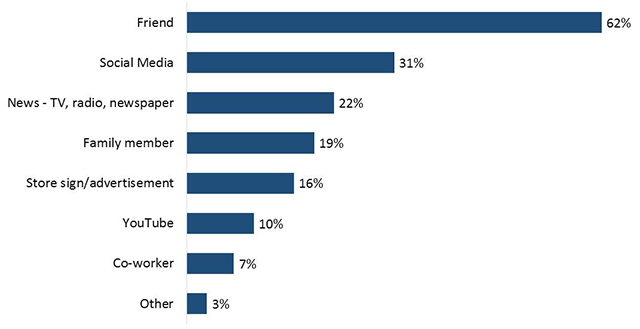
Text Description - Figure 7: Sources of E-Cigarette Awareness
Base: n=1,509; all surveyed respondents
MULTIPLE RESPONSES ACCEPTED
Q10. How did you first learn or hear about e-cigarettes?
Friends top the list of people in respondents' lives who use e-cigarettes. Just over half (53%) indicated that they have friends who use e-cigarettes. Over one-quarter (29%) said classmates use e-cigarettes, while one-in-five (20%) identified family members as users (multiple responses accepted). This was followed by 15% who identified co-workers and 6% who identified parents or guardian as users of e-cigarettes.
Young adults were more likely to say their friends as well as their co-workers are people in their lives that use e-cigarettes. In contrast, youth were more likely to say they have classmates who use e-cigarettes. Turning to gender, men were more likely to have a friend or co-worker who uses an e-cigarette, while women were apt to have a family member who does. Respondents who currently smoke cigarettes were more likely than non-smokers, and in some cases former smokers, to have a friend, classmate, family member or co-worker in their life who uses e-cigarettes.
Compared to non-users, e-cigarettes users were more likely to have different people in their lives who also use e-cigarettes. The differences for each type of person are as follows: friends (75% user vs. 33% non-user), classmates (36% user vs. 22% non-user), family members (27% user vs. 15% non-user), co-worker (20% user vs. 10% non-user), and parent or guardian (7% user vs. 4% non-user).
Figure 8: E-Cigarette Users in Personal Life
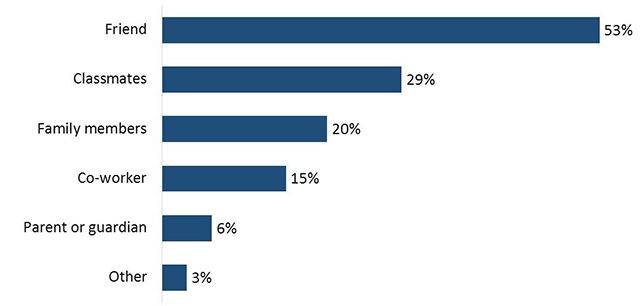
Text Description - Figure 8: E-Cigarette Users in Personal Life
Base: n=1,509; all surveyed respondents
MULTIPLE RESPONSES ACCEPTED
Q11. Do any of the following people in your life use e-cigarettes?
Users of e-cigarettes were asked which of the following statements about e-cigarettes is true:
In response, a majority chose the correct statement. Nearly two-thirds of e-cigarette users (64%) said that e-cigarettes sometimes contain nicotine. Just over one in five responded incorrectly, either by indicating that e-cigarettes always contain nicotine (14%) or never contain nicotine (8%). A further 14% said they did not know.
Figure 9: Knowledge of Nicotine Content
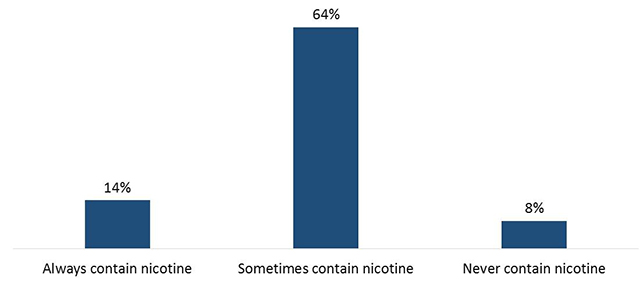
Text Description - Figure 9: Knowledge of Nicotine Content
Base: n=713; all e-cigarette users
Q14. Which of the following statements about e-cigarettes is correct?
Compared to youth, young adults were more likely to say that e-cigarettes always (17% vs 11%) or sometimes contain nicotine (68% vs 60%). Youth were more apt that young adults to believe that e-cigarettes never contain nicotine (11% vs 6%). The likelihood of saying that e-cigarettes always contain nicotine was higher in Quebec (21%), as well as among current smokers (16%) and daily e-cigarette users (21%).
One-time users of e-cigarettes (n=189) were asked to identify the top two reasons why they tried e-cigarettes. In response, three reasons were identified most frequently: because their friends were vaping (43%), because they liked the flavours and smell (40%), and because it was offered to them (39%) (multiple responses accepted).
This was followed by nearly one-quarter (23%) who said they tried an e-cigarette because it looked fun and exciting. Small numbers said they tried an e-cigarette in order to try to quit smoking (4%), or because they wanting to try it (3%).
Figure 10: First-Time Users' Reasons for Trying E-Cigarettes
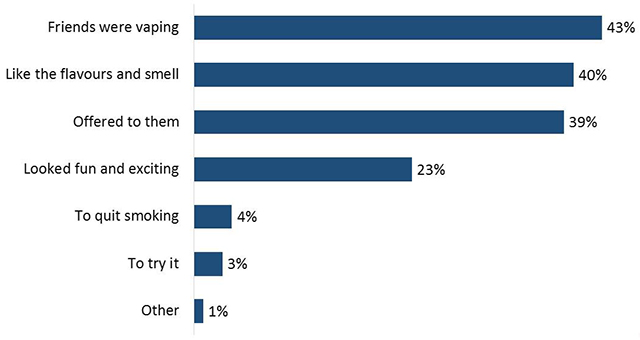
Text Description - Figure 10: First-Time Users' Reasons for Trying E-Cigarettes
Base: n=189; one-time users
MULTIPLE RESPONSES ACCEPTED
Q15. Why did you try an e-cigarette?
Youth (15 to 19 years old) were more likely to say they tried e-cigarettes because their friends were vaping (55% vs 32%). Conversely, young adults (20 to 24 years old) were more likely to say they tried because they liked the flavours and smell (48% vs 32%).
One-time and infrequent users of e-cigarettes were divided over whether or not they would try an e-cigarette again: 38% said they would, 32% said they would not, and 30% said they did not know.
Figure 11: Likelihood of Trying E-Cigarettes Again
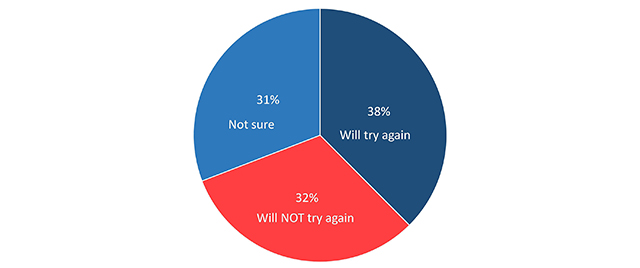
Text Description - Figure 11: Likelihood of Trying E-Cigarettes Again
Base: n=397; those who are first-time and infrequent smokers
Q16. Do you think you will try an e-cigarette again?
Among those who said they would not try e-cigarettes again or who did not know if they would (n=251), the main reasons cited were that it's not healthy (40%) and that it's unappealing (37%) (two responses accepted).
Figure 12: Reasons for Not Using E-Cigarettes Again
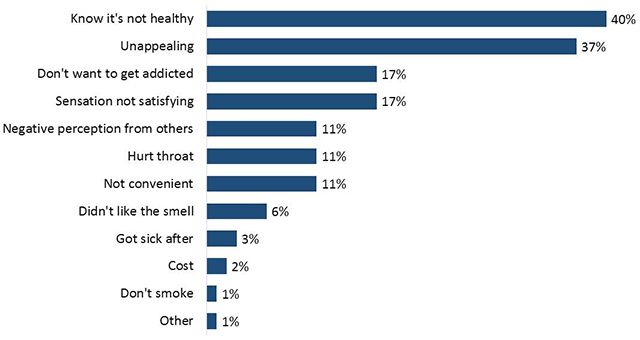
Text Description - Figure 12: Reasons for Not Using E-Cigarettes Again
Base: n=251; those who won't or don't know if they will try again
TWO RESPONSES ACCEPTED. Q17. Why would you not use an e-cigarette again?
These reasons were followed at a distance by equal proportions who said that they do not want to get addicted and that the sensation was not satisfying (17% each). Approximately one-in-ten (11%) said they would not use e-cigarettes again because of the negative perception of others, because it hurt their throat, and because it is not convenient. Smaller proportions said they wouldn't use again because they didn't like the smell (6%), because they got sick after vaping (3%), and because of the cost (2%).
Respondents from Quebec were less likely to say they will try an e-cigarette again (28%). Current smokers were more likely than former and non-smokers to say they will try an e-cigarette again (49% vs. 24% and 25%).
In addition, non-smokers were more likely than current and former smokers to cite e-cigarettes not being healthy as their reason for not using them again (50% vs. 33% and 42%). Non-smokers and former smokers were more likely to say they would not try e-cigarettes again because it was generally unappealing to them (49% and 42% vs. 26% of current smokers). Current smokers were more likely to say they would not try e-cigarettes again because the sensation was not satisfying (25% vs. 9% of former smokers and 12% of non-smokers).
Daily and occasional users of e-cigarettes (i.e. those using them daily or several times a month) (n=316) were asked if their frequency of use has changed since they first started using e-cigarettes. In response, the largest proportion (40%) said that their frequency of use has not changed. Most of the rest were equally divided between ones who said that it has increased and ones who said it has decreased (28% each). A small proportion (4%) said they did not know.
Figure 13: Frequency of E-Cigarette Use Over Time
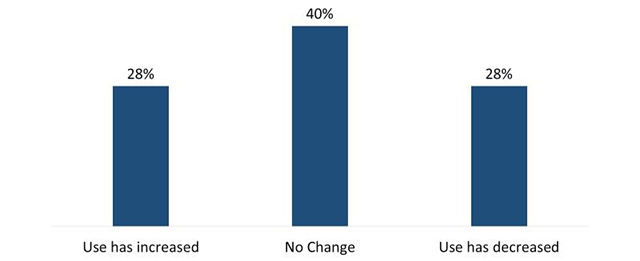
Text Description - Figure 13: Frequency of E-Cigarette Use Over Time
Base: n=316; daily and occasional e-cigarette users
Q18. Since you first started using e-cigarettes, has your frequency of use changed?
Youth were more likely to say their frequency of use has not changed since they started using e-cigarettes (47% vs 35%). Daily e-cigarette users were more likely than occasional users to report that their use has increased (45% vs. 21%).
A majority of daily and occasional users of e-cigarettes (59%) said they tend to use e-cigarettes at home. A substantial minority (43%) said they tend to use them at parties, while approximately one-quarter identified the sidewalk (29%), school (26%), while driving (24%), and work (23%) (multiple responses accepted). Locations cited less frequently included bars (14%), and movie theatres, pool halls etc. (10%).
Figure 14: Location of E-Cigarette Use
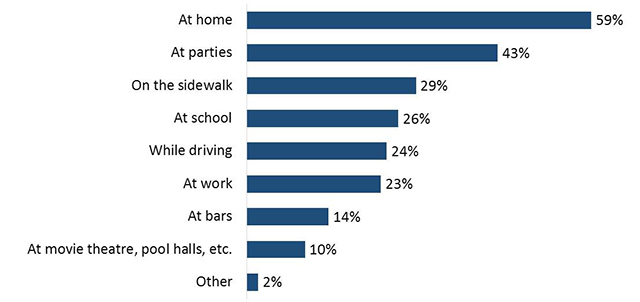
Text Description - Figure 14: Location of E-Cigarette Use
Base: n=316; daily and occasional e-cigarette users
MULTIPLE RESPONSES ACCEPTED
Q19. Where do you tend to use e-cigarettes?
Respondents 20 and 24 years old were more likely to say they use e-cigarettes at home (69% vs 48%) and while they are driving (31% vs 16%). Those between 15 and 19 were more apt to say they use them at parties (51% vs 36%), at school (36% vs 17%), or at movie theatres or pool halls (15% vs 5%). Compared to women, men were more likely to report using e-cigarettes at home (64% vs 53%) and at work (32% vs 12%).
Three-quarters of daily users of e-cigarettes (76%) said, that on a typical day, they vape within one hour of waking up, with almost half (46%) doing so almost immediately after waking (i.e. within 15 minutes of waking). Close to one in five (17%) said they wait at least an hour or more before vaping.
Figure 15: Length of Time After Waking Before Using an E-Cigarette
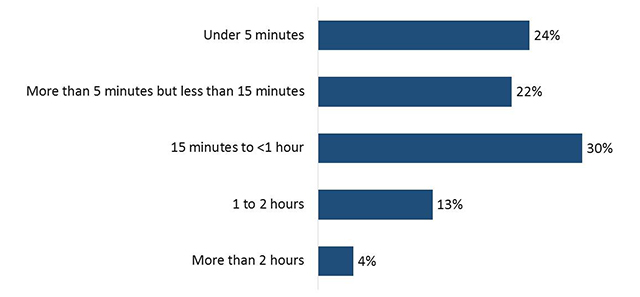
Text Description - Figure 15: Length of Time After Waking Before Using an E-Cigarette
Base: n=87; those who are daily e-cigarette users
Q20. On a typical day, how soon after you wake up do you use your e-cigarette?
When daily users were asked whether they have strong cravings to use an e-cigarette, more than half (57%) said they did, while one-third (33%) said they did not. One in ten said they did not know.
Figure 16: Strong Cravings to Use an E-Cigarette

Text Description - Figure 16: Strong Cravings to Use an E-Cigarette
Base: n=87; those who are daily e-cigarette users
Q21. Do you ever have strong cravings to use an e-cigarette?
Half (51%) of all e-cigarette users indicated that their parents are aware that they use e-cigarettes. Conversely, 40% said that their parents do not know about their use of e-cigarettes, while 9% said they did not know.
Figure 17: Parents' Awareness of E-Cigarette Use
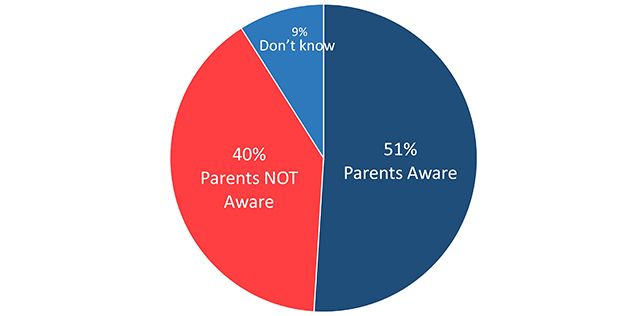
Text Description - Figure 17: Parents' Awareness of E-Cigarette Use
Base: n=713; all e-cigarette users.
Q22. Do your parents or guardian know that you use an e-cigarette?
Daily e-cigarette users (78%), current smokers (58%), and men (55%) were more likely to say that their parents or guardian know about their e-cigarette use.
Respondents whose parents are aware of their use of e-cigarettes (n=356) were asked which of the following statements describes their parents' or guardian's views of e-cigarettes:
Responses were mixed, with similar proportions attributing the following views to their parents or guardian: they don't really care that e-cigarettes are being used because they are less harmful than traditional cigarettes or other drugs (26%), they are worried about the health risks of using e-cigarettes (26%), they don't really care that e-cigarettes are being used (23%), and they are worried about the safety risks of e-cigarettes (23%) (up to three statements accepted).
Figure 18: Parents' Perceptions of E-Cigarettes
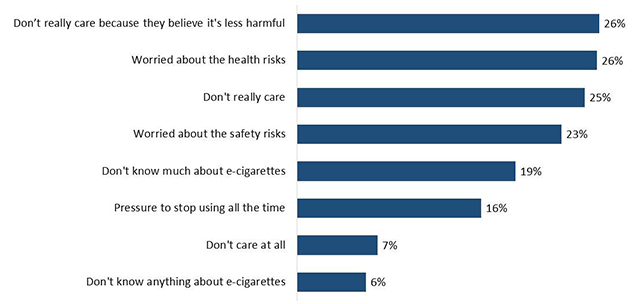
Text Description - Figure 18: Parents' Perceptions of E-Cigarettes
Base: n=356; those respondents' whose parents are aware
THREE RESPONSES ACCEPTED
Q23. Which of the following describes your parents' or guardian's view of e-cigarettes?
Approximately one-in-five (19%) indicated their parents or guardian doesn't know much about e-cigarettes, while slightly fewer (16%) said they are pressured to stop using e-cigarettes all the time. Smaller, and almost equal, proportions indicated that their parents or guardian don't care at all about what they put in their bodies (7%) and don't know anything about e-cigarettes (6%).
Youth were more likely than young adults to say that their parents are worried about the health (35% vs 18%) and safety risks (31% vs 16%) of e-cigarettes and that they pressure them to quit (21 vs 11%), while young adults were more likely to say that their parents do not care (30% vs 19%).
Asked if they had ever tried to stop using e-cigarettes, nearly two-thirds (64%) of daily and occasional e-cigarette users said they have not, while 32% said they have tried quitting (4% did not know). Asked if they think they will ever stop using e-cigarettes, 43% of these same respondents said yes, while nearly one-quarter (23%) said no, and approximately one-third (34%) said they were unsure/did not know.
Figure 19: Quitting E-Cigarettes Tried to Stop Using
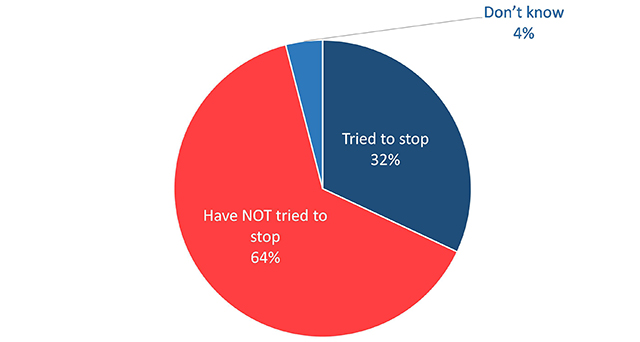
Text Description - Figure 19: Quitting E-Cigarettes Tried to Stop Using
Base: n=316; daily and occasional e-cigarette users.
Q24. Have you ever tried to stop using e-cigarettes?
Figure 20: Quitting E-Cigarettes Likelihood of Ever Quitting
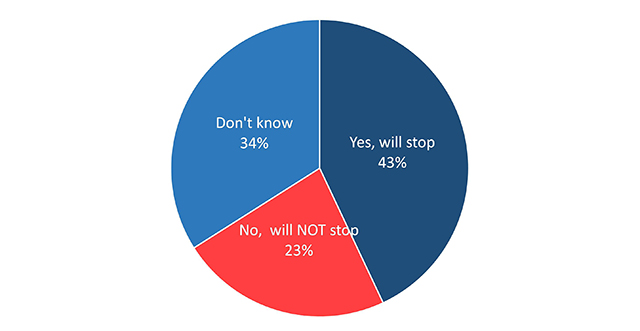
Text Description - Figure 20: Quitting E-Cigarettes Likelihood of Ever Quitting
Base: n=316; daily and occasional e-cigarette users.
Q25. Do you think you will stop using e-cigarettes?
A majority of respondents who are smokers as well as daily or occasional users of e-cigarettes (58%) said they have used e-cigarettes as an aide to quit smoking cigarettes. Conversely, 38% said they have not. The remaining 4% said they did not know or were unsure.
Daily e-cigarette users are more likely than occasional users to have used e-cigarettes for smoking cessation.
Figure 21: Use of E-Cigarettes to Quit Smoking
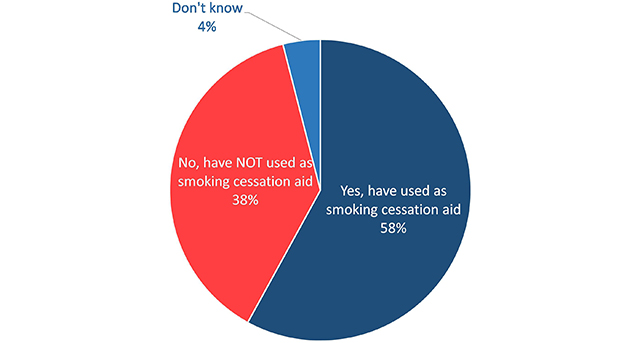
Text Description - Figure 21: Use of E-Cigarettes to Quit Smoking
Base: n=309; smokers who also use e-cigarettes
Q26. Have you ever used e-cigarettes to help you quit smoking cigarettes?
Among those who have not used an e-cigarette to quit smoking cigarettes (n=132), the majority (62%) said they would be likely to do this. That said, they were much more likely to indicate that they would be somewhat likely to do this (48%) than very likely to do it (14%). Among the rest, 14% said they were not very likely to do this, 5% said they were not at all likely to do it. Seven percent said they were not planning on quitting. In all, 12% said they did not know.
Figure 22: Likelihood of Using E-Cigarettes to Quit Smoking
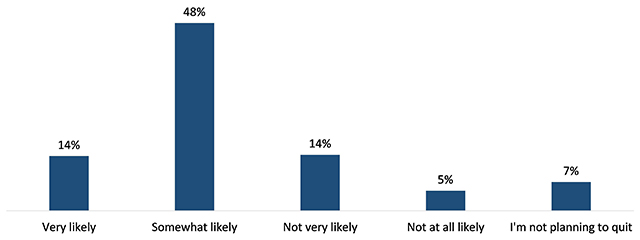
Text Description - Figure 22: Likelihood of Using E-Cigarettes to Quit Smoking
Base: n=132; those who have not tried e-cigarettes to quit cigarettes
Q27. How likely is it that you would consider using e-cigarettes as an aid to help you quit smoking cigarettes?
The majority of daily and occasional users of e-cigarette said they own their own device (fully 77% said they own a device, while 23% said they do not).
Figure 23: Devices Ownership
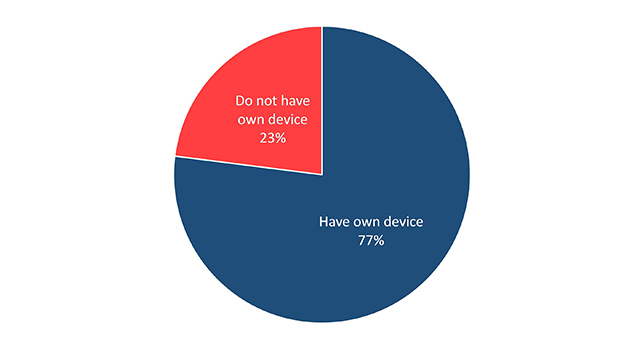
Text Description - Figure 23: Devices Ownership
Base: n=316; daily and occasional e-cigarette users
Q28. Do you have your own e-cigarette device?
Among those who own a device (n=244), more than half (58%) said they always use a device that can be refilled. A further 35% said they sometimes use one that can be refilled. Only 5% said they never use a refillable device (2% did not know).
Figure 24: Devices Use of Refillable Devices
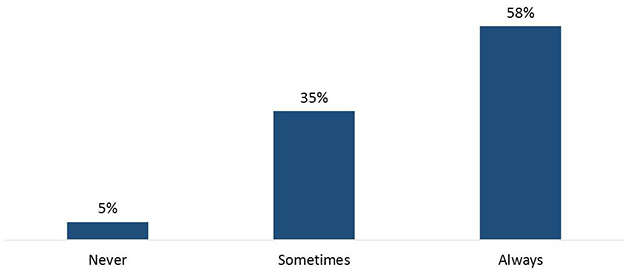
Text Description - Figure 24: Devices Use of Refillable Devices
Base: n=244; those who own a device
Q29. Do you use an e-cigarette that can be refilled?
Among owners of an e-cigarette device, a small majority (54%) said they sometimes use nicotine in their e-cigarette. Conversely, nearly one-quarter (23%) said they always use nicotine, while approximately one in five (19%) said they never use nicotine.
Figure 25: Nicotine Use in E-Cigarettes Frequency of Use
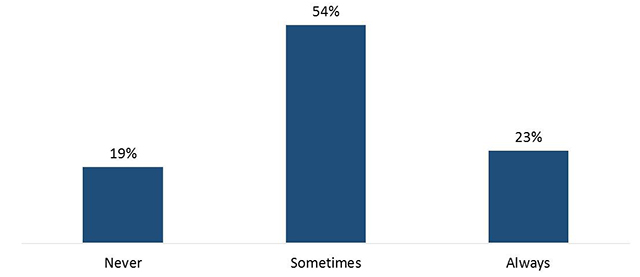
Text Description - Figure 25: Nicotine Use in E-Cigarettes Frequency of Use
Base: n=244; those who own a device
Q30. How often, if at all, do you use nicotine in your device?
Half of the respondents who use nicotine in their e-cigarette (51%) do not know what concentration of nicotine they use. Of those who do know the concentration,13% said they use 3mg/ml or 0.3%, while 10% said they use more than this and 6% said they use less than this.
Figure 26: Nicotine Use in E-Cigarettes Nicotine Concentration
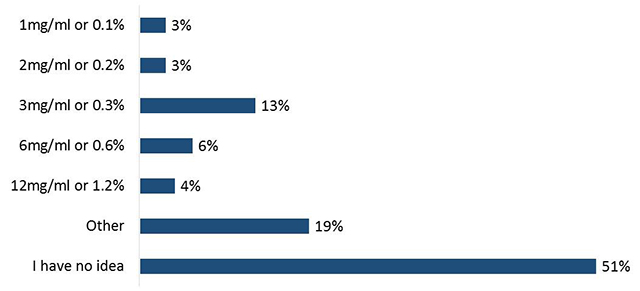
Text Description - Figure 26: Nicotine Use in E-Cigarettes Nicotine Concentration
Base: n=188; those who use nicotine
Q31. What concentration of nicotine do you typically use?
The most popular flavour by far among e-cigarette users is fruit. Asked what flavour they used last time they vaped, over one-third (37%) said fruit. This was followed at a distance by bubble gum (11%), coffee/ cappuccino (7%), tobacco (6%), dessert (6%), candy/ confectionary (5%), candy floss or marijuana (4%), soft drinks/energy drinks (3%), and cookies (2%).
Figure 27: E-Cigarette Flavour Preferences Last Flavour Used

Text Description - Figure 27: E-Cigarette Flavour Preferences Last Flavour Used
Base: n=713; all e-cigarette users
Q32. What flavour did you use the last time you used an e-cigarette?
The following table presents the results broken out by age segment (differences not statistically significant):
| Flavour | Youth | Young Adults |
|---|---|---|
| Fruit | 34% | 40% |
| Bubble gum | 12% | 11% |
| Coffee/cappuccino | 7% | 6% |
| Tobacco | 6% | 6% |
| Dessert | 7% | 4% |
| Candy/confectionary | 6% | 5% |
| Candy floss | 4% | 5% |
| Marijuana | 5% | 4% |
| Soft drinks/energy drinks | 3% | 4% |
| Cookies | 2% | 2% |
Asked specifically what flavour they prefer, nearly one-third (32%) of e-cigarette users said they prefer fruit. This was followed at a distance by bubble gum (9%), coffee/ cappuccino (7%), dessert and marijuana (6% each), candy/confectionary and candy floss (5% each), tobacco and soft drinks/energy drinks (4% each), and cookies (2%).
Included in the 'other' category are black cherry/cherry, alcohol, cereal, vanilla, and mint, among a small number of others.
Figure 29: E-Cigarette Flavour Preferences Preferred Flavour
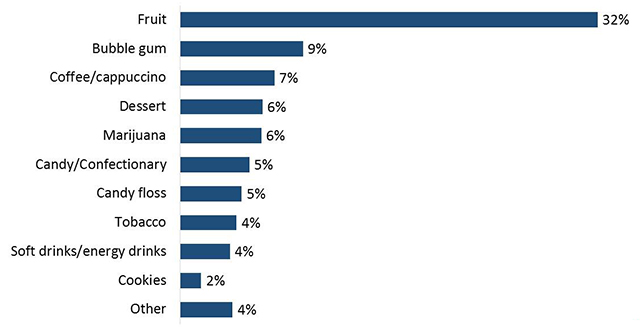
Text Description - Figure 29: E-Cigarette Flavour Preferences Preferred Flavour
Base: n=713; all e-cigarette users
Q33. What is your preferrede-cigarette flavour?
The following table presents the results broken out by age segment (statistically significant differences are noted using italics):
| Flavour | Youth | Young Adults |
|---|---|---|
| Fruit | 30% | 34% |
| Bubble gum | 12% | 7% |
| Coffee/cappuccino | 7% | 8% |
| Dessert | 7% | 5% |
| Marijuana | 6% | 7% |
| Candy/confectionary | 6% | 5% |
| Candy floss | 5% | 4% |
| Tobacco | 5% | 4% |
| Soft drinks/energy drinks | 3% | 5% |
| Cookies | 2% | 2% |
Daily and occasional e-cigarette users are most likely to acquire their e-cigarettes by purchasing them themselves. Nearly half (47%) said they usually buy their e-cigarettes at a store, while 20% said they buy them online, 12% from friends, and 8% from someone else (multiple responses accepted). Fewer, but a sizeable proportion nonetheless, said they usually borrow their e-cigarettes or get them from someone else. This includes 17% who said they get them from friends, 8% from someone else, and 7% from family members. Fourteen percent said they ask someone to purchase e-cigarettes for them.
Figure 31: Purchasing Habits
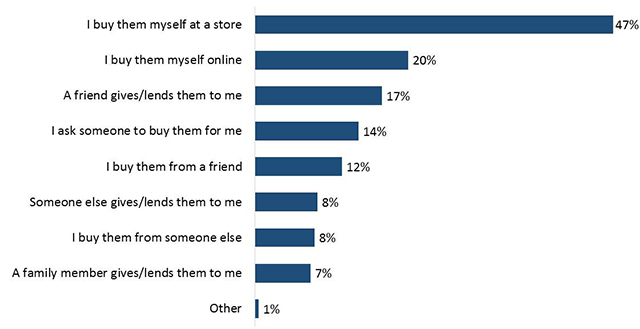
Text Description - Figure 31: Purchasing Habits
Base: n=316; daily and occasional e-cigarette users
MULTIPLE RESPONSES ACCEPTED
Q34. From where do you usually get your e-cigarettes?
Young adults are more likely than youth to say they buy their own e-cigarettes (57% vs 36%). Youths are more likely than young adults to say they ask someone else to buy them for them (22% vs. 6%) and that they buy them from someone else (11% vs. 5%).
Users of e-cigarettes (n=713) collectively identified a number of reasons why they vape, but flavour and aroma topped the list with nearly half (45%) identifying this as the reason they use e-cigarettes. Close to one-third explained that they vape because their friends do (31%) or because it's safer than smoking traditional cigarettes (30%). In addition, almost equal numbers said that they like doing tricks with the vapour (22%), that it's fun and exciting (21%), and that they use to help them quit cigarettes (20%) (multiple responses accepted).
Figure 32: Reasons for E-Cigarette Use
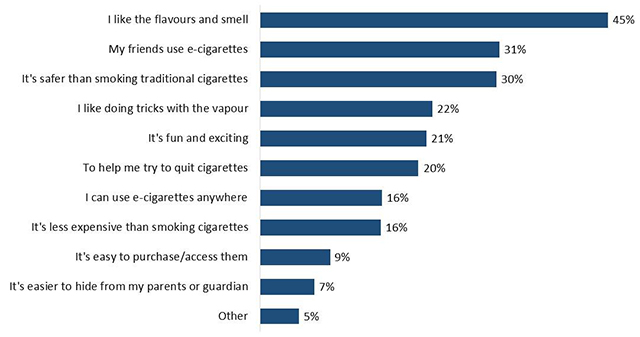
Text Description - Figure 32: Reasons for E-Cigarette Use
Base: n=713; all e-cigarette users
THREE RESPONSES ACCEPTED
Q35. Why do you use e-cigarettes?
This was followed by equal numbers (16% each) who said they can use e-cigarettes because they can vape anywhere and they are less expensive than cigarettes. Smaller numbers said they use e-cigarettes because it's easy to purchase them (9%) and because it is easier to hide their use from their parents (7%).
Youth were more likely than young adults to say they use e-cigarettes because their friends do (39% vs 24%). Occasional and infrequent users were more likely than daily users to say they use e-cigarettes because they like the flavours and smell (52% and 50% vs 30%).
Two perceived disadvantages of using e-cigarettes were most frequently identified by vapers: the associated health risks and the cost, each identified by 55% of e-cigarette users. Sizeable proportions also identified the potential of becoming addicted (43%) and the social stigma associated with using e-cigarettes (37%), while one in five (20%) identified having to vape outdoors, and 16% identified the smell (multiple responses accepted).
Women were more likely to mention the following disadvantages: the associated health risks (60%), the cost (60%), and the potential to become addicted (48%). Among e-cigarette users, the likelihood of saying the associated health risks are a disadvantage decreased with use, from one-timer users (66%) to daily users (34%). Current cigarette smokers were more likely to point to having to smoke outside (23%) and the social stigma of using e-cigarettes (39%) as disadvantages, while former smokers were more apt to mention the associated health risks (64%).
Figure 33: Perceived Disadvantages of E-Cigarettes

Text Description - Figure 33: Perceived Disadvantages of E-Cigarettes
Base: n=713; all e-cigarette users
THREE RESPONSES ACCEPTED
Q36. What would you say are the main disadvantages of using e-cigarettes?
All respondents were asked to rate the extent to which they think people risk harming themselves when they do each of the following activities:
With one exception, a majority of respondents consider all of these activities at least moderately risky. However, the size of the majority varied considerably, ranging from 90% to 52%. Respondents were most likely to rate regular use of cigarettes and e-cigarettes containing nicotine as risky. Fully 90% rated regular use of cigarettes as at least moderately risky while 82% felt that way about regular use of e-cigarettes containing nicotine. That said, regular use of cigarettes was much more likely to be seen as a 'great' risk than regular use of e-cigarettes containing nicotine (76% vs. 46%).
Nearly three-quarters of respondents (74%) consider occasional use of cigarettes as at least somewhat risky while close to two-thirds (63%) felt that way about occasional use of e-cigarettes containing nicotine. Here again, occasional use of cigarettes was more likely to be seen as posing a 'great' risk than occasional use of e-cigarettes containing nicotine (28% vs. 19%).
Just over half (52%) rated using nicotine-free e-cigarettes on a regular basis as risky, though they were much more likely to rate this as a moderate risk (36%) than a great risk (16%).
Occasional use of nicotine-free e-cigarettes was the only activity which a majority viewed as posing no more than a slight risk (59%). That said, just over one-third (35%) rated this as at least moderately risky.
Figure 34: Perceived Risks of Smoking and Vaping
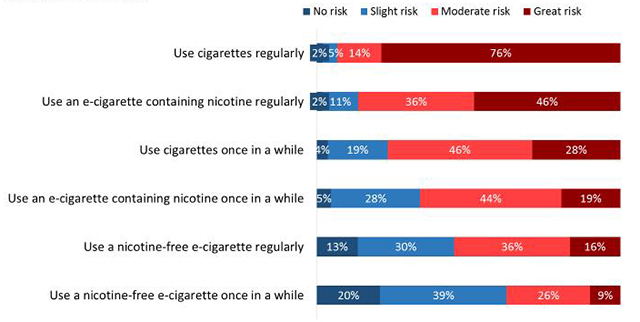
Text Description - Figure 34: Perceived Risks of Smoking and Vaping
Base: n=1,509; all surveyed respondents
Q37. How much do you think people risk harming themselves when they do each of the following activities?
Figure 35 displays the results by e-cigarette use. Apart from using nicotine-free e-cigarettes once in a while, non-users were more likely than e-cigarette users to perceive every risk as a great risk. Among e-cigarette users, occasional users were more likely to view all the risks as moderate as opposed to great.
| E-Cigarette Status | ||||||||
|---|---|---|---|---|---|---|---|---|
| User | Non-User | |||||||
| No Risk | Slight Risk | Moderate Risk | Great Risk | No Risk | Slight Risk | Moderate Risk | Great Risk | |
| Use cigarettes regularly | 3% | 7% | 20% | 67% | 1% | 3% | 9% | 85% |
| Use an e-cigarette containing nicotine regularly | 3% | 15% | 42% | 36% | 1% | 7% | 32% | 55% |
| Use cigarettes once in a while | 6% | 22% | 48% | 22% | 2% | 16% | 45% | 34% |
| Use an e-cigarette containing nicotine once in a while | 6% | 35% | 44% | 10% | 3% | 21% | 45% | 26% |
| Use a nicotine-free e-cigarette regularly | 15% | 36% | 34% | 10% | 10% | 24% | 37% | 20% |
| Use a nicotine-free e-cigarette once in a while | 25% | 41% | 24% | 7% | 15% | 37% | 28% | 12% |
Overall, men and current smokers attributed moderate or great risk to fewer items than women and former smokers.
Respondents were asked to rate the extent to which they agree or disagree with the following statements:
Respondents' views regarding most of these statements were mixed. Only in relation to two statements did a majority pronounce itself one way or another, with over three-quarters agreeing that one can become addicted to e-cigarettes containing nicotine (79%) and that nicotine is a toxic chemical that should be avoided (77%). In neither case, however, did a majority of respondents 'strongly' agree with the statement.
In relation to all other statements, opinion tended to be divided between those agreeing, those disagreeing, and those neither agreeing nor disagreeing. That said, respondents were more likely to agree than disagree with the following: that e-cigarettes are no better than regular cigarettes (47% vs. 29%), that e-cigarettes don't have the same chemical content as cigarettes and are safer to use (38% vs. 29%), that using an e-cigarette is embarrassing/not cool (37% vs. 27%), and that nicotine-free e-cigarettes pose little health risks to users (36% vs. 31%). Conversely, respondents were slightly more likely to disagree than agree that using e-cigarettes will lead to smoking regular cigarettes (32% vs. 30%) and somewhat more likely to disagree than agree that smoking regular cigarettes is not socially acceptable but using an e-cigarette is not a big deal (42% vs. 25%).
The proportion of respondents neither agreeing nor disagreeing with all these statements ranged from 10% regarding whether one can become addicted to e-cigarettes with nicotine to 30% regarding whether using an e-cigarette is embarrassing/not cool.
Figure 36: Attitudes Towards E-Cigarettes and Nicotine
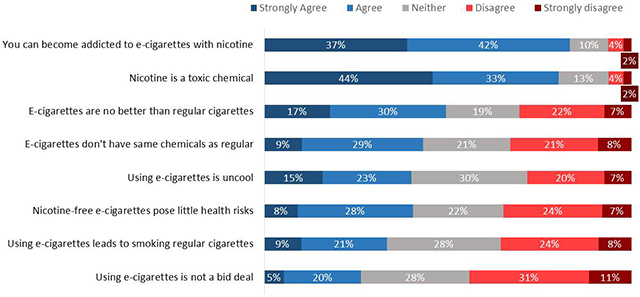
Text Description - Figure 36: Attitudes Towards E-Cigarettes and Nicotine
Base: n=1,509; all surveyed respondents
Q38. Please rate the extent to which you agree or disagree with the following statements?
Figure 37 displays the results by e-cigarette use.
| E-Cigarette Status | ||||||||
|---|---|---|---|---|---|---|---|---|
| User | Non-User | |||||||
| Strongly Agree | Agree | Disagree | Strongly Disagree | Strongly Agree | Agree | Disagree | Strongly Disagree | |
| You can become addicted to e-cigarettes with nicotine | 30% | 43% | 6% | 2% | 43% | 40% | 2% | 1% |
| Nicotine is a toxic chemical | 32% | 37% | 6% | 3% | 55% | 29% | 2% | 2% |
| E-cigarettes are no better than regular cigarettes | 9% | 24% | 26% | 11% | 25% | 34% | 18% | 3% |
| E-cigarettes don't have same chemicals as regular | 13% | 34% | 15% | 5% | 6% | 25% | 26% | 10% |
| Using e-cigarettes is uncool | 9% | 21% | 29% | 8% | 21% | 24% | 13% | 5% |
| Nicotine-free e-cigarettes pose little health risks | 10% | 35% | 19% | 3% | 7% | 22% | 29% | 10% |
| Using e-cigarettes leads to smoking regular cigarettes | 6% | 19% | 30% | 12% | 11% | 23% | 19% | 5% |
| Using e-cigarettes not a big deal | 7% | 26% | 25% | 6% | 3% | 15% | 36% | 14% |
Women were more likely to agree with the statements than men. Women agreed that you can become addicted to e-cigarettes with nicotine (82% vs 76%), that nicotine is a toxic chemical (80% vs 74%), and that e-cigarettes are no better than regular cigarettes (50% vs 44%). Conversely, men were more a likely to agree that e-cigarettes don't have the same chemicals as regular cigarettes (42% vs 35%) and that using e-cigarettes is not a big deal (30% vs 21%).
Turning to smoking status, current smokers were more likely than former smokers to agree using nicotine e-cigarettes poses little health risks (48% vs 38%) and e-cigarettes don't have the same chemicals as regular cigarettes (48% vs 40%).
Users of e-cigarettes (n=713) were asked what type of information on e-cigarettes, if any, they have looked for. The most commonly mentioned information health effects (42%). This was followed by information about content/ingredients, with one-third looking for information on ingredients (33%) and chemicals (32%) in e-cigarette liquids. Just over one-quarter (27%) have looked for safety information, including general product safety and information about explosions and device defects, while almost as many have looked for information comparing e-cigarettes to regular cigarettes (24%), information about choosing nicotine levels (24%), and information about the cost of e-cigarettes (23%) (multiple responses accepted).
Figure 38: E-Cigarette Information Sought
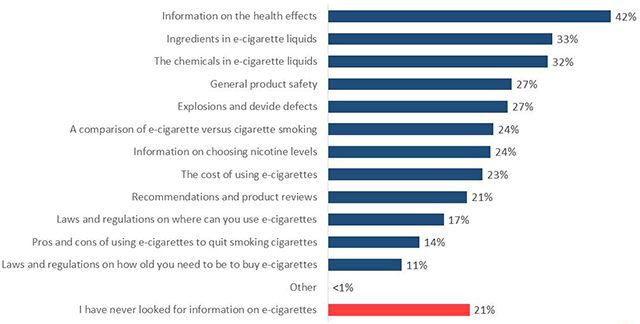
Text Description - Figure 38: E-Cigarette Information Sought
Base: n=713; all e-cigarette users
MULTIPLE RESPONSES ACCEPTED
Q39. What type of information, if any, have you looked for on e-cigarettes?
Following this, in declining order of frequency are information related to recommendations and product reviews (21%), laws and regulations on where one can use e-cigarettes (17%), pros and cons of using e-cigarettes to quit smoking cigarettes (14%), and laws and regulations on how old one needs to be to buy e-cigarettes (11%).
Just over one in five users (21%) say they have never looked for information on e-cigarettes.
Men were more likely than women to have sought information on the chemicals in liquids (36% vs 28%), explosions and device defects (31% vs 22%), choosing nicotine levels (28% vs 20%), and product recommendation (24% vs 16%). Among e-cigarette users, the likelihood of never looking for information on e-cigarettes was higher among one-time and infrequent users (34% and 22%).
Online sources in one form or another constitute the main source of information for users of e-cigarettes (n=713) regarding the health risks or benefits of using e-cigarettes. Google leads the way, with over one-third of e-cigarette users (37%) identifying it as a source for such information. Google was followed at a distance by a cluster of online sources identified by similar proportions of respondents. These include Facebook (17%), online forums (16%), online news outlets (15%), and YouTube (14%) (up to three responses accepted). Online sources identified less frequently include Reddit (8%), Instagram (6%), and Pubmed/Google Scholar (4%).
Figure 39: Sources of E-Cigarette Information
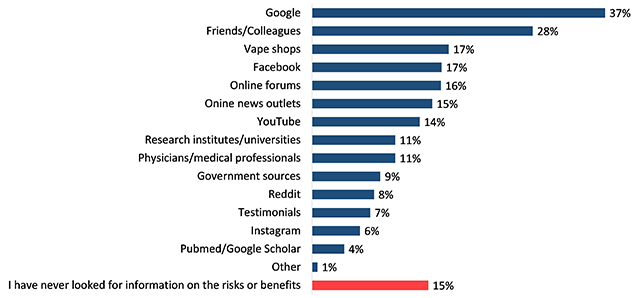
Text Description - Figure 39: Sources of E-Cigarette Information
Base: n=713; all e-cigarette users
THREE RESPONSES ACCEPTED
Q40. From which sources do you get information on the risks or benefits to your health of using e-cigarettes?
The most frequently identified non-Internet source of information was friends and colleagues, identified by just over one-quarter of respondents (28%). This was followed at a distance by vape shops (17%). Approximately one-in-ten said they consult research institutes/universities (11%), physicians/medical professionals (11%), and government sources (9%). The only other source identified with any frequency was testimonials (7%). It should be noted that these sources (i.e. health professionals, research institutes, government, testimonials) may also be accessible online, thereby underscoring the importance of online sources when it comes to getting information about e-cigarettes.
In all, 15% of e-cigarette users said they have never looked for information on the risks or benefits of using e-cigarettes.
Among e-cigarette users, the likelihood of never looking for information on the risks or benefits of e-cigarettes was higher among one-time and infrequent users.
The tables below provide a profile of survey respondents (all data are weighted).
| Gender | Age Cohort | Total | |
|---|---|---|---|
| 15-19 | 20-24 | ||
| Male | 51% | 49% | 50% |
| Female | 48% | 50% | 49% |
| Prefer not to say | 1% | 1% | 1% |
| Language | Age Cohort | Total | |
|---|---|---|---|
| 15-19 | 20-24 | ||
| English | 81% | 84% | 82% |
| French | 19% | 16% | 18% |
| Age | Age Cohort | Total | |
|---|---|---|---|
| 15-19 | 20-24 | ||
| 15 | 21% | -- | 10% |
| 16 | 20% | -- | 10% |
| 17 | 20% | -- | 10% |
| 18 | 17% | -- | 9% |
| 19 | 22% | -- | 11% |
| 20 | -- | 18% | 9% |
| 21 | -- | 20% | 10% |
| 22 | -- | 20% | 10% |
| 23 | -- | 21% | 10% |
| 24 | -- | 21% | 10% |
| Education Level | Age Cohort | Total | |
|---|---|---|---|
| 15-19 | 20-24 | ||
| Less than high school (no certificate, diploma or degree) | 47% | 3% | 25% |
| High School diploma or equivalent | 36% | 34% | 35% |
| Registered Apprenticeship or other trades certificate or diploma | 2% | 5% | 3% |
| College, CEGEP or non-university certificate or diploma | 6% | 22% | 14% |
| University certificate or diploma below bachelor's level | 3% | 9% | 6% |
| Bachelor's degree | 2% | 21% | 11% |
| Post graduate degree above bachelor's level | 1% | 4% | 2% |
| Prefer not to say | 3% | 2% | 3% |
| Location | Age Cohort | Total | |
|---|---|---|---|
| 15-19 | 20-24 | ||
| Alberta | 11% | 11% | 11% |
| British Columbia | 11% | 13% | 12% |
| Manitoba | 4% | 4% | 4% |
| New Brunswick | 2% | 3% | 2% |
| Newfoundland and Labrador | 2% | 1% | 1% |
| Nova Scotia | 3% | 2% | 3% |
| Northwest Territories | 0% | 0% | 0% |
| Ontario | 39% | 39% | 39% |
| Prince Edward Island | 1% | 0% | 0% |
| Quebec | 25% | 23% | 24% |
| Saskatchewan | 3% | 2% | 3% |
| Prefer not to say | 0% | 1% | 0% |
Recruit 12 participants.
Participants to be paid $125.
For each location, two groups will be held with youth (aged 15-19) and young adult (aged 20-24) participants who are e-cigarette users and the other two will be held with youth and young adult participants who are e-cigarette non-users.
Each group will have a mix of participants who are of cigarette smoking and non-smoking status.
Group 1 |
Group 2 |
Group 3 |
Group 4 |
Group 5 |
Group 6 |
Group 7 |
Group 8 Montreal Young adult (Non-user) |
Group 9 |
Group 10 |
Group 11 |
Group 12 |
Hello/Bonjour, my name is [INSERT NAME]. Would you prefer to continue in English or French? / Préférez-vous continuer en anglais ou en français?
[INTERVIEWER NOTE: FOR ENGLISH GROUPS, IF PARTICIPANT WOULD PREFER TO CONTINUE IN FRENCH, PLEASE RESPOND WITH, "Malheureusement, nous recherchons des gens qui parlent anglais pour participer à ces groupes de discussion. Nous vous remercions de votre intérêt."]
INTRO: I'm calling from Research House, a Canadian research firm. We're organizing a series of discussion groups on behalf of the Government of Canada to explore issues of importance to Canadians. The groups will last up to two hours and people who take part will receive a cash gift to thank them for their time. The format is a "round table" discussion led by a research professional with up to ten participants. All opinions will remain anonymous and will be used for research purposes only in accordance with laws designed to protect your privacy. Before we invite you to attend, we need to ask you a few questions to ensure that we get a good mix of people in each of the groups. This will take 5 minutes. May I continue?
[INTERVIEWER NOTE: IF ASKED ABOUT PRIVACY LAWS, SAY: "The information collected through the research is subject to the provisions of the Privacy Act, legislation of the Government of Canada, and to the provisions of relevant provincial privacy legislation."]
[INTERVIEWER NOTE: IF THE CHILD IS NOT HOME, AND THE PARENT CONSENTS, ASK FOR THE CHILD'S NAME AND ARRANGE A TIME TO CALL BACK]
[INTERVIEWER NOTE: IF THE CHILD IS NOT HOME, AND THE PARENT CONSENTS, ASK FOR THE CHILD'S NAME AND ARRANGE A TIME TO CALL BACK]
[INTERVIEWER NOTE: ARRANGE A TIME TO CALL BACK IF THE PARENT/GUARDIAN IS NOT HOME]
Hello, I'm calling from Research House, a Canadian research firm. We're organizing a series of discussion groups on behalf of the Government of Canada to explore issues of importance to Canadians. May we have your permission to ask your child some questions to see if s/he qualifies for the discussion group which will take place on [INSERT DATE] at [TIME]? The group will last up to 2 hours and your child will receive $125.00 for his/her time. The groups are being conducted on behalf of Health Canada to help them develop regulations and information campaigns about e-cigarettes. Your written consent for your child to participate in the focus group will be required upon arrival.
- Yes CONTINUE
- No THANK/DISCONTINUE
[SKIP Q8 IF NO AT Q7]
[ASK IF NOT AT ALL AT Q9]
Recruit at least two per group who are of non-European descent or who are other visible minorities (i.e. Chinese or South Asian, but could include aboriginal people or Afro-Canadians as well).
TERMINATE IF RESPONDENT OFFERS ANY REASON SUCH AS SIGHT OR HEARING PROBLEM, A WRITTEN OR VERBAL LANGUAGE PROBLEM, A CONCERN WITH NOT BEING ABLE TO COMMUNICATE EFFECTIVELY.
INVITATION TO PARTICIPATE: I would like to invite you to attend the focus group session where you will exchange your opinions in a moderated discussion with other Canadians from your community. The discussion will be lead by a researcher from the national public opinion research firm, Phoenix SPI. The session will be taped and observed, but your participation will be confidential. The group will take place on [DAY OF WEEK], [DATE], at [TIME]. It will last two hours. People who attend will receive $125 to thank them for their time. Would you be willing to attend?
Do you have a pen handy so that I can give you the address where the group will be held? It will be held at [INSERT FACILITY]. I would like to remind you that the group is at [TIME] on [DATE]. We ask that you arrive 15 minutes early.
At the facility, you will be asked to produce photo identification, so please remember to bring something with you (for example, a driver's license). If you use glasses to read, please remember to bring them with you. [INTERVIEWER NOTE: PLEASE ASK PARTICIPANT TO BRING WRITTTEN CONSENT FORM TO FOCUS GROUP. "Please ensure that you bring a written consent form from your parent or guardian to participate in this group"].
The session will be video recorded for research purposes and representatives of the Government of Canada research team will be observing from an adjoining room. You will be asked to sign a waiver to acknowledge that you will be video recorded during the session. The recordings will be used only by the Phoenix SPI research team and Health Canada clients (for research purposes only) and will not be shared with others. As I mentioned, all information collected in the group discussion will remain anonymous and be used for research purposes only in accordance with laws designed to protect your privacy.
As we are only inviting a small number of people to attend, your participation is very important to us. If for some reason you are unable to attend, please call us so that we can get someone to replace you. You can reach us at [INSERT NUMBER] at our office. Please ask for [INSERT NAME].
Someone will call you the day before to remind you about the session.
[15 YEAR OLDS ONLY: In the next few days we will be sending your parent or legal guardian a letter by email. The letter will have instructions on what you need to do for the discussion group, as well as a consent form that your parent or legal guardian must sign and return to us in advance of the group. Could I please confirm your name, your parent's name, phone number, and your parent's email address (or fax #, if applicable)?]
PARENT/GUARDIAN
So that we can call you to remind you about the focus group or contact you should there be any changes, can you please confirm your name and contact information for me?
PARTICIPANT
Thank participants for attending
Introduce moderator and Phoenix
Tonight, we are conducting research on behalf of Health Canada to discuss electronic, or e-cigarettes.
My job is to facilitate the discussion, keeping us on topic and on time.
Your job is to offer your opinions about the issues to be covered tonight.
Comments treated in confidence; reporting in aggregate form only; recording for report writing purposes only; observers behind one-way glass and watching online/listening by phone (adjust/use as appropriate)
If you have a cell phone or other electronic device, please turn it off.
Any questions?
Roundtable introduction: Please tell us your first name and a hobby you have.
When you were recruited for this study, all of you said you use or have tried e-cigarettes. I'd like to begin with a few general questions about your use patterns or behaviours …
1. How long have you been using e-cigarettes? [MODERATOR: LET PARTICIPANTS KNOW WE ARE NOT DISCUSSING THE USE OF E-CIG DEVICES FOR MARIJUANA SMOKING; NOTE HOW MANY USE E-CIGS AND ALSO VAPE CANNABIS]
2. How many of you use e-cigarettes on a daily basis? [HAND COUNT]
3. For those of you who do, approximately how many times a day do you use your e-cigarette?
4. For those who don't, how often do you use e-cigarettes?
5. How many of you also smoke regular cigarettes [HAND COUNT]?
6. At the present time, do you smoke cigarettes every day or only occasionally?
7. Why do you use e-cigarettes and smoke cigarettes?
When you were recruited for this study, some of you said you are a cigarette smoker …
8. For those of you who smoke cigarettes, at the present time, do you smoke cigarettes every day or only occasionally?
9. How long have you been smoking? And, have you ever tried to quit?
10. As I mentioned, tonight we're going to be discussing e-cigarettes. Before this evening, how many of you had heard of or seen e-cigarettes? [HAND COUNT] [MODERATOR: IF NEEDED, EXPLAIN WHAT E-CIGS ARE: E-cigarettes are battery-powered smoking devices which are sometimes designed to look and feel like regular cigarettes.]
11. For those of you aware of e-cigarettes, what do you know about them? [MODERATOR: IF NEEDED, LET PARTICIPANTS KNOW WE ARE NOT DISCUSSING THE USE OF E-CIG DEVICES FOR MARIJUANA SMOKING]
Probe:
12. How did you first hear/learn about e-cigarettes?
Probe:
13. Does anyone know someone who uses e-cigarettes?
Probe:
14. Where have you seen people using e-cigarettes, or vaping?
Probe:
15. Have you been able to smell the liquid when people are vaping around you? How did it smell--sweet, spicy, tobacco? Were you bothered by the smell?
16. Some of the liquids used by e-cigarette users have names like "island breeze", "unicorn puke" or "golden ticket"? Who do you think flavours like these are marketed to and why?
Now I'd like to focus on the first time you encountered or became acquainted with e-cigarettes.
17. How did you first hear/learn about e-cigarettes?
Probe:
18. [USERS] What was the context or situation in which you first tried an e-cigarette? [MODERATOR: WATCH FOR DIFFERENCES BETWEEN CIGARETTE SMOKERS AND NON-SMOKERS]
Probe:
[NON-USERS] Have you ever been offered an e-cigarette? If so, by whom and where? [MODERATOR: WATCH FOR DIFFERENCES BETWEEN CIGARETTE SMOKERS AND NON-SMOKERS]
19. [USERS] What prompted or encouraged you to try an e-cigarette? [MODERATOR: WATCH FOR DIFFERENCES BETWEEN CIGARETTE SMOKERS AND NON-SMOKERS]
[NON-USERS] Why did you decide not to try vaping? Lack of appeal? [MODERATOR: WATCH FOR DIFFERENCES BETWEEN CIGARETTE SMOKERS AND NON-SMOKERS]
Probe:
These next questions are about your patterns or behaviours when it comes to using e-cigarettes. For those of you who don't use e-cigarettes regularly, please think about the time or times you've used one.
20. E-cigarettes are prohibited in a lot of places. In general, where do you use them?
Probe:
21. Does your usage pattern change depending on who you're with or where you are?
Probe:
For those of you who also smoke cigarettes,
22. How, if at all, does your use of e-cigarettes differ from your use of regular cigarettes?
Probe:
Changing the focus a bit…..[MODERATOR: PAY ATTENTION TO DIFFERENCES BY CIGARETTE SMOKER STATUS]
23. Where/how do you acquire e-cigarettes? Do you get your liquids and devices from the same place? If not, why not?
Probe:
24. What type of e-cigarettes do you use/have you tried? "Cig-a-likes" containing pre-filled cartridges of vaping liquid or advanced vaping devices that require you to add the liquid? Both? Why do you use this type(s)?
25. For those of you who use/have used "cig-a-likes", do you use disposable or rechargeable ones?
26. For those of you who use/have used advanced devices, do you customize your device? If so, what parts and why?
Probe:
27. Currently, is the liquid you use nicotine-free, containing nicotine, or both [HAND COUNT; NOTE HOW MANY DO NOT KNOW IF THE LIQUID CONTAINS NICOTINE]?
28. What strength of nicotine do you use? Why?
29. Has it changed over time? Why?
30. Did you start with liquid containing nicotine?
31. Why did you change to nicotine-free liquid?
32. Do any of you mix your own liquids? Why/why not? If so, do you mix flavours, nicotine strengths, or brands (regular or premium)?
33. How many different flavours have you tried?
34. How many flavours do you use currently? [NOTE NUMBER WHO USE MORE THAN ONE] For those who use multiple flavours, why is that? Is it just for variety? For those who don't change flavours, why don't you? Habit, preference, convenience (too much trouble/need to clean tank/filter to switch flavours)?
35. How do/did you choose your flavour(s)?
Probe:
36. How often do you switch flavours?
37. What appeals to you about this/these flavours?
38. Is there a pattern to your use of flavours?
39. Do any of you use non-descriptive flavours like "island breeze", "unicorn puke" or "golden ticket"? For those who do, what do you like about them? For everyone else, who do you think flavours like these are marketed to and why?
These next few questions are about [USERS: your] reasons for using e-cigarettes.
40. [USERS] Why do you use e-cigarettes?
Probe for drivers/motivating factors:
[ROTATE NEXT TWO QUESTIONS]
41. [USERS] When you think about using e-cigarettes, what would you say are the main advantages...why do you use e-cigarettes, what do you get out of them? [USE FLIP CHART]
[NON-USERS] When you think about e-cigarettes, what would you say are the main advantages...why do you think people use e-cigarettes, what do they get out of them? [USE FLIP CHART]
Probe (as needed):
42. [USERS] And when you think about using e-cigarettes, what would you say are the main disadvantages of them? [USE FLIP CHART]
[NON-USERS] And when you think about e-cigarettes, what would you say are the main disadvantages of them? [USE FLIP CHART]
Probe (as needed):
43. How dependent would you say you are you on e-cigarettes? Why do you say that?
44. Do you foresee yourself stopping the use of e-cigarettes? Why/why not?
45. Do you think you would ever start using e-cigarettes? Why/why not? MODERATOR: PAY ATTENTION TO DIFFERENCES BY CIGARETTE SMOKER STATUS]
46. For those of you who smoke cigarettes, do you think you would use e-cigarettes as an aid to help you quit smoking? Why/ why not?
Changing topics,
47. [BOTH] Have you seen any advertising for e-cigarettes? If so, where did you see ads and what were the nature of the ads?
48. [BOTH] Who do you think advertising for e-cigarettes is directed at? Why do you say that?
49. [USERS] Where do you get your information about e-cigarettes?
Probe:
[NON-USERS] If you wanted to get information about e-cigarettes, where would you go and why?
Probe:
50. [USERS] In your opinion, what information is important for someone to have in order to make an informed decision about whether or not to begin using e-cigarettes? Why?
[NON-USERS] In your opinion, what information would be important for someone to have in order to make an informed decision about whether or not to begin using e-cigarettes? Why?
51. [USERS] Is there any information you do not currently have about e-cigarettes but would like to have?
52. What, if any, are the health risks associated with smoking e-cigarettes? [NOTE DISTINCTION BETWEEN NICOTINE-FREE AND NICOTINE-CONTAINING E-CIGARETTES. WATCH FOR DIFFERENCE BETWEEN CIGARETTE SMOKERS AND NON-SMOKERS.]
53. And what about benefits…are there any health benefits associated with smoking e-cigarettes? If so, what are they?
I'm going to pass around a double-sided document. Please look at only the side facing up for now and answer the questions. When everyone is done, we'll talk about what you put for each question. [HANDOUT ONE DOCUMENT, THEN CONTINUE.]
54. Just a quick show of hands…how many put "1" meaning it's not at all harmful? Why do you say that? And how put….[INSERT SCALE AND CONTINUE TO "5"]?
Now I'd like you to rate your level of agreement or disagreement with the following statement: "I believe e-cigarettes are no better than smoking regular cigarettes." Please flip over the paper in front of you to respond, and provide at least one reason to support your view.
55. One again, just a quick show of hands…how many put "1" meaning you strongly disagree? And how many put [INSERT SCALE AND CONTINUE TO "5"]?
56. For those of you who agreed with the statement, either moderately or strongly, why do you think this?
57. And what about those who disagreed with the statement, either moderately or strongly, why do you think this?
58. [USERS]: Where do you get information on the risks or benefits to your health when it comes to e-cigarettes?
[NON-USERS]: If you wanted information on the risks or benefits to your health when it comes to e-cigarettes, where would you go?
Probe:
59. [USERS]: Do you trust these sources? If so, why? If, not why not?
Probe: Do they trust some sources over others?
[NON-USERS]: Which of these sources do you view as being must trustworthy when it comes to providing information about health-related risks or benefits? Why?
60. Do you have any final comments or ideas you'd like to offer before we conclude?
Thank you very much for your time and thoughtful feedback. It is very much appreciated.
I believe e-cigarettes are no better than smoking regular cigarettes.
Thank you for agreeing to take part in this short survey on e-cigarettes. We anticipate that the survey will take 10 minutes to complete and it is registered with the national survey registration system.
[NEXT]
Background information
This research is being conducted by Phoenix Strategic Perspectives (Phoenix SPI), a Canadian public opinion research firm on behalf of Health Canada.
The purpose of this online survey is to collect opinions and feedback from youth and young adults that will be used by Health Canada in the development of regulations relating to e-cigarettes and in the design of educational public materials.
How does the online survey work?
What about your personal information?
What happens after the online survey?
The final report written by Phoenix SPI will be available to the public from Library and Archives Canada (http://www.bac-lac.gc.ca/).
If you have any questions about the survey, you may contact Phoenix SPI at research@phoenixspi.ca.
Your assistance is greatly appreciated, and we look forward to receiving your feedback.
[CONTINUE]
We would like to conduct this survey with your 15 year old teenager. In this survey, we will ask your child questions about e-cigarettes. You may watch your teen while they are taking the survey. Would you like them to continue?
This research is being conducted by Phoenix Strategic Perspectives (Phoenix SPI), a Canadian public opinion research firm on behalf of Health Canada.
The purpose of this online survey is to collect opinions and feedback from youth and young adults that will be used by Health Canada in the development of regulations relating to e-cigarettes and in the design of educational public materials.
How does the online survey work?
What about your child's personal information?
What happens after the online survey?
The final report written by Phoenix SPI will be available to the public from Library and Archives Canada (http://www.bac-lac.gc.ca/).
If you have any questions about the survey, you may contact Phoenix SPI at research@phoenixspi.ca.
Before hitting the continue button, please have your teen available to begin answering the following questions. We welcome you to sit with your teen while they participate in this survey, but we ask that you allow your teen to answer the questions themselves.
[CONTINUE]
HYPERLINK NATIONAL SURVEY REGISTRATION SYSTEM. TEXT:
The registration system has been created by the survey research industry to allow the public to verify that a survey is legitimate, get information about the survey industry or register a complaint. The registration system's toll-free phone number is 1-800-554-9996.
SECTION TITLES SHOULD NOT APPEAR ON SCREEN FOR RESPONDENTS.
DO NOT PRESENT QUESTION NUMBERS ON SCREEN FOR RESPONDENTS.
INCLUDE A PROGRESS BAR.
ALL QUESTIONS ARE MANDATORY, BUT INCLUDE A DON'T KNOW OPTION
1. What is your age?
[TEXT BOX]
TERMINATE IF UNDER 15 OR OVER 24
2. In the previous 30 days, which, if any, of the following have you participated in?
Select all that apply
3. Do you, or any member of your household or immediate family, work for…
Select all that apply
TERMINATION MESSAGE:
Thank you very much for your interest in completing this survey. Unfortunately, you are not eligible for this survey.
4. At the present time, do you smoke cigarettes every day, occasionally or not at all? This includes cigarettes that are bought ready-made, as well as cigarettes that people make themselves.
5. How long have you been smoking cigarettes?
6. Have you ever smoked cigarettes?
7. Have you ever tried an electronic cigarette, also known as an e-cigarette*?
PROGRAMMING NOTE: "e-cigarette" hyperlink with the following description: E-cigarettes are battery-powered vaping devices which are sometimes designed to look and feel like regular cigarettes. These devices are used to heat e-liquid into vapour you can inhale. Note: we are not interested in information on THC or marijuana vaping.
8. Which did you try first?
9. Before this survey, had you heard of e-cigarettes?
10. How did you first learn or hear about e-cigarettes?
Select all that apply
11. Do any of the following people in your life use e-cigarettes?
Select all that apply
12. Which of the following statements best describes your use of e-cigarettes?
SHOW IF OCCASIONAL USER:
13. How old were you when you first tried an e-cigarette?
14. Which of the following statements about e-cigarettes is correct?
15. Why did you try an e-cigarette?
Select the top 2 reasons
[ROTATE]
16. Do you think you will try an e-cigarette again?
17. Why would you not use an e-cigarette again?
Select the top 2 reasons
[ROTATE]
1-TIME AND INFREQUENT USERS GO TO Q22
18. Since you first started using e-cigarettes, has your frequency of use changed?
19. Where do you tend to use e-cigarettes?
Select all that apply
20. On a typical day, how soon after you wake up do you use your e-cigarette (i.e., have your first vape/puff of the day)?
21. Do you ever have strong cravings to use an e-cigarette?
22. Do your parents or guardian know that you use e-cigarettes?
23. Which of the following describe your parents' or guardian's view of e-cigarettes?
Select up to three statements that apply
[ROTATE]
1-TIME AND INFREQUENT USERS GO TO Q32
24. Have you ever tried to stop using e-cigarettes?
25. Do you think you will stop using e-cigarettes?
26. Have you ever used e-cigarettes to help you quit smoking cigarettes?
27. How likely is it that you would consider using e-cigarettes as an aid to help you quit smoking cigarettes?
28. Do you have your own e-cigarette device?
29. Do you use an e-cigarette that can be refilled?
30 How often, if at all, do you use nicotine in your device?
31. What concentration of nicotine do you typically use?
32. What flavour did you use the last time you used an e-cigarette?
33. What is your preferred e-cigarette flavour?
1-TIME AND INFREQUENT USERS GO TO Q37
34. From where do you usually get your e-cigarettes?
Select all that apply
[ROTATE]
35. Why do you use e-cigarettes?
Select the top 3 reasons
[ROTATE]
36. What would you say are the main disadvantages of using e-cigarettes?
Select the top 3 reasons
[ROTATE]
37. How much do you think people risk harming themselves when they do each of the following activities?
[RANDOMIZE ORDER; GRID/TABLE FORMAT]
[RESPONSE OPTIONS]
38. Please rate the extent to which you agree or disagree with the following statements.
[RANDOMIZE ORDER; GRID/TABLE FORMAT]
[RESPONSE OPTIONS]
NON-USERS GO TO DEMOGRAPHIC
You're almost finished the survey. These last questions are on sources of information about e-cigarettes.
39. What type of information, if any, have you looked for on e-cigarettes?
Select all that apply
40. From which sources do you get information on the risks or benefits to your health of using e-cigarettes?
Select the top 3 sources
[ROTATE]
These last questions will help us group your answers with others that we will receive in this survey.
41. In which province or territory are you located?
42. What is the highest level of formal education that you have completed?
43. What is your gender?
That concludes the survey. The results will be available at the Library and Archives Canada website in the coming months. Thank you very much for your thoughtful feedback. It is much appreciated.
Total email addresses used: 52,620 (estimate)
Invalid cases: 0
Unresolved (U): 06
In-scope non-responding units (IS): 128
Responding units (R): 2,631
I hereby certify as a Senior Officer of Phoenix Strategic Perspectives that the deliverables fully comply with the Government of Canada political neutrality requirements outlined in the Communications Policy of the Government of Canada and Procedures for Planning and Contracting Public Opinion Research. Specifically, the deliverables do not contain any reference to electoral voting intentions, political party preferences, standings with the electorate, or ratings of the performance of a political party or its leader.
Alethea Woods
President
Phoenix Strategic Perspectives Inc.
For this survey, probability sampling was not feasible given the known incidence rates of the target audience (youth and young adult smokers and e-cigarette users).
Exercise caution when interpreting results for daily users due to the relatively small sample size (n=87).
These included 'zen' and 'tropica'.
Caution should be exercised when interpreting results for daily users due to the relatively small sample size (n=87).
Caution should be exercised when interpreting results for daily users due to the relatively small sample size (n=87).
This does not apply. Panels do not use a traditional email invitation.